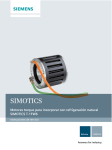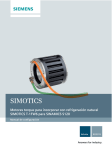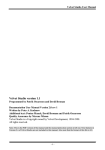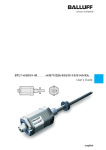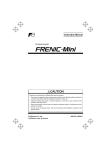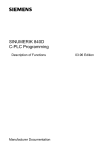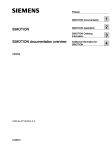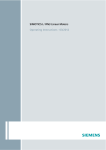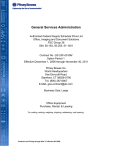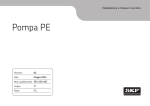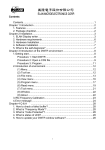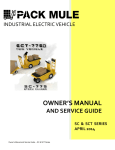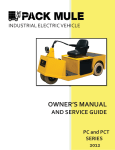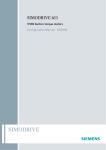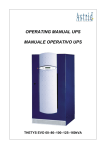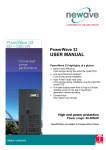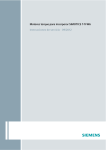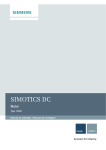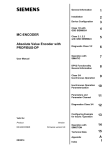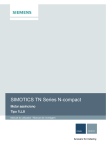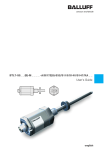Download - Service, Support
Transcript
Naturally cooled SIMOTICS T-1FW6 ___________________ Introduction built-in torque motors Fundamental safety 1 ___________________ instructions 2 ___________________ Description Drive Technology Naturally cooled SIMOTICS T-1FW6 built-in torque motors Operating Instructions 3 ___________________ Preparation for use 4 ___________________ Mechanical installation 5 ___________________ Electrical connection 6 ___________________ Commissioning 7 ___________________ Operation 8 ___________________ Maintenance Decommissioning and 9 ___________________ disposal A ___________________ Appendix 10/2014 6SN1197-0AF02-0BP1 Legal information Warning notice system This manual contains notices you have to observe in order to ensure your personal safety, as well as to prevent damage to property. The notices referring to your personal safety are highlighted in the manual by a safety alert symbol, notices referring only to property damage have no safety alert symbol. These notices shown below are graded according to the degree of danger. DANGER indicates that death or severe personal injury will result if proper precautions are not taken. WARNING indicates that death or severe personal injury may result if proper precautions are not taken. CAUTION indicates that minor personal injury can result if proper precautions are not taken. NOTICE indicates that property damage can result if proper precautions are not taken. If more than one degree of danger is present, the warning notice representing the highest degree of danger will be used. A notice warning of injury to persons with a safety alert symbol may also include a warning relating to property damage. Qualified Personnel The product/system described in this documentation may be operated only by personnel qualified for the specific task in accordance with the relevant documentation, in particular its warning notices and safety instructions. Qualified personnel are those who, based on their training and experience, are capable of identifying risks and avoiding potential hazards when working with these products/systems. Proper use of Siemens products Note the following: WARNING Siemens products may only be used for the applications described in the catalog and in the relevant technical documentation. If products and components from other manufacturers are used, these must be recommended or approved by Siemens. Proper transport, storage, installation, assembly, commissioning, operation and maintenance are required to ensure that the products operate safely and without any problems. The permissible ambient conditions must be complied with. The information in the relevant documentation must be observed. Trademarks All names identified by ® are registered trademarks of Siemens AG. The remaining trademarks in this publication may be trademarks whose use by third parties for their own purposes could violate the rights of the owner. Disclaimer of Liability We have reviewed the contents of this publication to ensure consistency with the hardware and software described. Since variance cannot be precluded entirely, we cannot guarantee full consistency. However, the information in this publication is reviewed regularly and any necessary corrections are included in subsequent editions. Siemens AG Division Digital Factory Postfach 48 48 90026 NÜRNBERG GERMANY Order number: 6SN1197-0AF02-0BP1 Ⓟ 12/2014 Subject to change Copyright © Siemens AG 2013 - 2014. All rights reserved Introduction These operating instructions describe the motor and explain how to handle the motor from the delivery to the disposal stage. ● Before you start using the motor, you must read these operating instructions to ensure safe, problem-free operation and to maximize the service life. These operating instructions complement the relevant SIEMENS Configuration Manual. Siemens strives continually to improve the quality of information provided in these operating instructions. ● If you find any mistakes or would like to offer suggestions about how this document could be improved, contact the Siemens Service Center. ● Always follow the safety instructions and notices in these operating instructions. The warning notice system is explained on the rear of the inside front. Text features In addition to the notes that you must observe for your own personal safety as well as to avoid material damage, in these operating instructions you will find the following text features: Operating instructions Operating instructions with the specified sequence are designated using the following symbols: The arrow indicates the start of the operating instructions. The individual handling steps are numbered. 1. Execute the operating instructions in the specified sequence. The square indicates the end of the operating instruction. Operating instructions without a specified sequence are identified using a bullet point: ● Execute the operating instructions. Enumerations ● Enumerations are identified by a bullet point without any additional symbols. – Enumerations at the second level are hyphenated. Naturally cooled SIMOTICS T-1FW6 built-in torque motors Operating Instructions, 10/2014, 6SN1197-0AF02-0BP1 5 Introduction Notes Notes are shown as follows: Note A Note is an important item of information about the product, handling of the product or the relevant section of the document. Notes provide you with help or further suggestions/ideas. Target group These operating instructions are intended for electricians, fitters, service technicians and warehouse personnel. Training The following link provides information on SITRAIN - training from Siemens for products, systems and automation engineering solutions: http://siemens.com/sitrain Technical Support Country-specific telephone numbers for technical support are provided on the Internet under Contact: http://www.siemens.com/automation/service&support Recommended additional documents System components Manufacturer's manuals Motor • Configuration Manual • Safety instructions for direct drives Encoder system • User Manual • Operating Instructions Brake • Operating Instructions Sensor module • Manual Drive system • Commissioning Manual • List Manual • Function Manual Naturally cooled SIMOTICS T-1FW6 built-in torque motors 6 Operating Instructions, 10/2014, 6SN1197-0AF02-0BP1 Introduction More information Information on the following topics is available under the link: ● Ordering documentation/overview of documentation ● Additional links to download documents ● Using documentation online (find and search in manuals/information) http://www.siemens.com/motioncontrol/docu Please send any questions about the technical documentation (e.g. suggestions for improvement, corrections) to the following e-mail address: [email protected] Current manuals and operating instructions for motors / direct drives are available on the Internet under the following link: http://www.siemens.com/motioncontrol/docu Any manuals or operating instructions that you may have in printed or electronic file form could be of an older product version. You can also request all descriptions and safety instructions from your local Siemens office. My Documentation Manager The following link provides information on how to create your own individual documentation based on Siemens content, and adapt it for your own machine documentation: http://www.siemens.com/mdm Differences to the configuration manual In contrast to the configuration manual, the operating instructions are independent of the drive system. The operating instructions do not contain any data sheets or installation/ dimension drawings. Information on the configuring and ordering of the motors is also not part of these operating instructions. Websites of third parties This publication contains hyperlinks to websites of third parties. Siemens does not take any responsibility for the contents of these websites or adopt any of these websites or their contents as their own, because Siemens does not control the information on these websites and is also not responsible for the contents and information provided there. Use of these websites is at the risk of the person doing so. Internet address for products http://www.siemens.com/motioncontrol Naturally cooled SIMOTICS T-1FW6 built-in torque motors Operating Instructions, 10/2014, 6SN1197-0AF02-0BP1 7 Introduction Standards and regulations The product complies with the standards relating to the Low-Voltage Directive stated in the EC Declaration of Conformity. The EC Declaration of Conformity for the Low Voltage Directive can be found in the Appendix. The motor components and also the packaging comply with EC directive 2002/95/EC (RoHS). Naturally cooled SIMOTICS T-1FW6 built-in torque motors 8 Operating Instructions, 10/2014, 6SN1197-0AF02-0BP1 Table of contents Introduction ............................................................................................................................................. 5 1 2 3 Fundamental safety instructions ............................................................................................................ 11 1.1 General safety instructions .....................................................................................................11 1.2 Handling electrostatic sensitive devices (ESD) ......................................................................15 1.3 Industrial security ....................................................................................................................16 1.4 Residual risks during the operation of electric motors ............................................................17 Description ............................................................................................................................................ 19 2.1 Use for the intended purpose .................................................................................................19 2.2 2.2.1 2.2.2 2.2.3 2.2.4 2.2.5 2.2.6 2.2.7 Technical features and ambient conditions ............................................................................20 Danger from strong magnetic fields ........................................................................................20 Technical features ...................................................................................................................25 Defining the direction of rotation .............................................................................................26 Environment conditions for fixed locations .............................................................................26 Degree of protection ...............................................................................................................27 Noise emission ........................................................................................................................28 Vibration response ..................................................................................................................28 2.3 Rating plate data .....................................................................................................................29 2.4 2.4.1 2.4.2 2.4.2.1 2.4.2.2 2.4.3 2.4.4 Design .....................................................................................................................................30 Motor components ..................................................................................................................30 Scope of delivery ....................................................................................................................31 Naturally-ventilated built-in torque motor ................................................................................31 Supplied pictograms ...............................................................................................................31 Cooling ....................................................................................................................................32 Temperature monitoring and thermal motor protection ..........................................................33 Preparation for use ............................................................................................................................... 37 3.1 Shipment and packaging ........................................................................................................38 3.2 3.2.1 3.2.2 3.2.3 3.2.4 Transport and storage.............................................................................................................39 Safety instructions for transport and storage ..........................................................................39 Ambient conditions for long term storage and transport .........................................................41 Storage ...................................................................................................................................42 Packaging specifications for transport by air ..........................................................................43 Naturally cooled SIMOTICS T-1FW6 built-in torque motors Operating Instructions, 10/2014, 6SN1197-0AF02-0BP1 9 Table of contents 4 5 6 7 8 9 A Mechanical installation .......................................................................................................................... 45 4.1 Safety instructions for assembling the motor ......................................................................... 45 4.2 Forces that occur between the stator and rotor ..................................................................... 48 4.3 Installation device................................................................................................................... 49 4.4 Specifications for mounting torque motors ............................................................................ 52 4.5 Procedure for mounting the motor ......................................................................................... 54 4.6 Checking the work carried out ............................................................................................... 55 Electrical connection ............................................................................................................................. 57 5.1 Safety notes for electrical connections .................................................................................. 57 5.2 Important data for 1FW6 cables ............................................................................................. 60 5.3 PIN assignments for the connectors ...................................................................................... 61 5.4 Power connection................................................................................................................... 61 5.5 Temperature sensor connection ............................................................................................ 62 5.6 1FW6 circuit diagram ............................................................................................................. 63 5.7 Shielding, grounding, and equipotential bonding ................................................................... 64 Commissioning ..................................................................................................................................... 65 6.1 Safety guidelines for commissioning...................................................................................... 65 6.2 Checklists ............................................................................................................................... 70 6.3 Checking the insulation resistance ........................................................................................ 73 Operation .............................................................................................................................................. 75 7.1 Safety guidelines for operation .............................................................................................. 75 7.2 Dealing with faults .................................................................................................................. 76 Maintenance ......................................................................................................................................... 79 8.1 Safety instructions for maintenance ....................................................................................... 79 8.2 Inspection and maintenance .................................................................................................. 83 Decommissioning and disposal ............................................................................................................. 85 9.1 Decommissioning ................................................................................................................... 85 9.2 9.2.1 9.2.2 Disposal ................................................................................................................................. 85 Disposing of 1FW6 rotors ...................................................................................................... 86 Disposal of packaging ............................................................................................................ 87 Appendix .............................................................................................................................................. 89 A.1 Standards ............................................................................................................................... 89 A.2 Declaration of conformity ....................................................................................................... 90 A.3 List of abbreviations ............................................................................................................... 91 Index .................................................................................................................................................... 93 Naturally cooled SIMOTICS T-1FW6 built-in torque motors 10 Operating Instructions, 10/2014, 6SN1197-0AF02-0BP1 Fundamental safety instructions 1.1 1 General safety instructions DANGER Danger to life due to live parts and other energy sources Death or serious injury can result when live parts are touched. • Only work on electrical devices when you are qualified for this job. • Always observe the country-specific safety rules. Generally, six steps apply when establishing safety: 1. Prepare for shutdown and notify all those who will be affected by the procedure. 2. Disconnect the machine from the supply. – Switch off the machine. – Wait until the discharge time specified on the warning labels has elapsed. – Check that it really is in a no-voltage condition, from phase conductor to phase conductor and phase conductor to protective conductor. – Check whether the existing auxiliary supply circuits are de-energized. – Ensure that the motors cannot move. 3. Identify all other dangerous energy sources, e.g. compressed air, hydraulic systems, or water. 4. Isolate or neutralize all hazardous energy sources by closing switches, grounding or short-circuiting or closing valves, for example. 5. Secure the energy sources against switching on again. 6. Ensure that the correct machine is completely interlocked. After you have completed the work, restore the operational readiness in the inverse sequence. WARNING Danger to life through a hazardous voltage when connecting an unsuitable power supply Touching live components can result in death or severe injury. • Only use power supplies that provide SELV (Safety Extra Low Voltage) or PELV(Protective Extra Low Voltage) output voltages for all connections and terminals of the electronics modules. Naturally cooled SIMOTICS T-1FW6 built-in torque motors Operating Instructions, 10/2014, 6SN1197-0AF02-0BP1 11 Fundamental safety instructions 1.1 General safety instructions WARNING Danger to life when live parts are touched on damaged motors/devices Improper handling of motors/devices can damage them. For damaged motors/devices, hazardous voltages can be present at the enclosure or at exposed components. • Ensure compliance with the limit values specified in the technical data during transport, storage and operation. • Do not use any damaged motors/devices. WARNING Danger to life through electric shock due to unconnected cable shields Hazardous touch voltages can occur through capacitive cross-coupling due to unconnected cable shields. • As a minimum, connect cable shields and the conductors of power cables that are not used (e.g. brake cores) at one end at the grounded housing potential. WARNING Danger to life due to electric shock when not grounded For missing or incorrectly implemented protective conductor connection for devices with protection class I, high voltages can be present at open, exposed parts, which when touched, can result in death or severe injury. • Ground the device in compliance with the applicable regulations. WARNING Danger to life due to electric shock when opening plug connections in operation When opening plug connections in operation, arcs can result in severe injury or death. • Only open plug connections when the equipment is in a no-voltage state, unless it has been explicitly stated that they can be opened in operation. Naturally cooled SIMOTICS T-1FW6 built-in torque motors 12 Operating Instructions, 10/2014, 6SN1197-0AF02-0BP1 Fundamental safety instructions 1.1 General safety instructions WARNING Danger to life through unexpected movement of machines when using mobile wireless devices or mobile phones Using mobile wireless devices or mobile phones with a transmit power > 1 W closer than approx. 2 m to the components may cause the devices to malfunction, influence the functional safety of machines therefore putting people at risk or causing material damage. • Switch the wireless devices or mobile phones off in the immediate vicinity of the components. WARNING Danger of an accident occurring due to missing or illegible warning labels Missing or illegible warning labels can result in accidents involving death or serious injury. • Check that the warning labels are complete based on the documentation. • Attach any missing warning labels to the components, in the national language if necessary. • Replace illegible warning labels. WARNING Danger to life when safety functions are inactive Safety functions that are inactive or that have not been adjusted accordingly can cause operational faults on machines that could lead to serious injury or death. • Observe the information in the appropriate product documentation before commissioning. • Carry out a safety inspection for functions relevant to safety on the entire system, including all safety-related components. • Ensure that the safety functions used in your drives and automation tasks are adjusted and activated through appropriate parameterizing. • Perform a function test. • Only put your plant into live operation once you have guaranteed that the functions relevant to safety are running correctly. Note Important safety notices for Safety Integrated functions If you want to use Safety Integrated functions, you must observe the safety notices in the Safety Integrated manuals. Naturally cooled SIMOTICS T-1FW6 built-in torque motors Operating Instructions, 10/2014, 6SN1197-0AF02-0BP1 13 Fundamental safety instructions 1.1 General safety instructions WARNING Danger to life from electromagnetic fields Electromagnetic fields (EMF) are generated by the operation of electrical power equipment such as transformers, converters or motors. People with pacemakers or implants are at a special risk in the immediate vicinity of these devices/systems. • Ensure that the persons involved are the necessary distance away (minimum 2 m). WARNING Danger to life from permanent magnet fields Even when switched off, electric motors with permanent magnets represent a potential risk for persons with heart pacemakers or implants if they are close to converters/motors. • If you are such a person (with heart pacemaker or implant) then keep a minimum distance of 2 m. • When transporting or storing permanent magnet motors always use the original packing materials with the warning labels attached. • Clearly mark the storage locations with the appropriate warning labels. • IATA regulations must be observed when transported by air. WARNING Injury caused by moving parts or those that are flung out Touching moving motor parts or drive output elements and loose motor parts that are flung out (e.g. feather keys) in operation can result in severe injury or death. • Remove any loose parts or secure them so that they cannot be flung out. • Do not touch any moving parts. • Safeguard all moving parts using the appropriate safety guards. WARNING Danger to life due to fire if overheating occurs because of insufficient cooling Inadequate cooling can cause overheating resulting in death or severe injury as a result of smoke and fire. This can also result in increased failures and reduced service lives of motors. • Comply with the specified coolant requirements for the motor. Naturally cooled SIMOTICS T-1FW6 built-in torque motors 14 Operating Instructions, 10/2014, 6SN1197-0AF02-0BP1 Fundamental safety instructions 1.2 Handling electrostatic sensitive devices (ESD) WARNING Danger to life due to fire as a result of overheating caused by incorrect operation When incorrectly operated and in the case of a fault, the motor can overheat resulting in fire and smoke. This can result in severe injury or death. Further, excessively high temperatures destroy motor components and result in increased failures as well as shorter service lives of motors. • Operate the motor according to the relevant specifications. • Only operate the motors in conjunction with effective temperature monitoring. • Immediately switch off the motor if excessively high temperatures occur. CAUTION Risk of injury due to touching hot surfaces In operation, the motor can reach high temperatures, which can cause burns if touched. • Mount the motor so that it is not accessible in operation. When maintenance is required • allow the motor to cool down before starting any work. • Use the appropriate personnel protection equipment, e.g. gloves. 1.2 Handling electrostatic sensitive devices (ESD) Electrostatic sensitive devices (ESD) are individual components, integrated circuits, modules or devices that may be damaged by either electric fields or electrostatic discharge. Naturally cooled SIMOTICS T-1FW6 built-in torque motors Operating Instructions, 10/2014, 6SN1197-0AF02-0BP1 15 Fundamental safety instructions 1.3 Industrial security NOTICE Damage through electric fields or electrostatic discharge Electric fields or electrostatic discharge can cause malfunctions through damaged individual components, integrated circuits, modules or devices. • Only pack, store, transport and send electronic components, modules or devices in their original packaging or in other suitable materials, e.g conductive foam rubber of aluminum foil. • Only touch components, modules and devices when you are grounded by one of the following methods: – Wearing an ESD wrist strap – Wearing ESD shoes or ESD grounding straps in ESD areas with conductive flooring • Only place electronic components, modules or devices on conductive surfaces (table with ESD surface, conductive ESD foam, ESD packaging, ESD transport container). 1.3 Industrial security Note Industrial security Siemens provides products and solutions with industrial security functions that support the secure operation of plants, solutions, machines, equipment and/or networks. They are important components in a holistic industrial security concept. With this in mind, Siemens’ products and solutions undergo continuous development. Siemens recommends strongly that you regularly check for product updates. For the secure operation of Siemens products and solutions, it is necessary to take suitable preventive action (e.g. cell protection concept) and integrate each component into a holistic, state-of-the-art industrial security concept. Third-party products that may be in use should also be considered. For more information about industrial security, visit Hotspot-Text (http://www.siemens.com/industrialsecurity). To stay informed about product updates as they occur, sign up for a product-specific newsletter. For more information, visit Hotspot-Text (http://support.automation.siemens.com). Naturally cooled SIMOTICS T-1FW6 built-in torque motors 16 Operating Instructions, 10/2014, 6SN1197-0AF02-0BP1 Fundamental safety instructions 1.4 Residual risks during the operation of electric motors WARNING Danger as a result of unsafe operating states resulting from software manipulation Software manipulation (e.g. by viruses, Trojan horses, malware, worms) can cause unsafe operating states to develop in your installation which can result in death, severe injuries and/or material damage. • Keep the software up to date. You will find relevant information and newsletters at this address (http://support.automation.siemens.com). • Incorporate the automation and drive components into a holistic, state-of-the-art industrial security concept for the installation or machine. You will find further information at this address (http://www.siemens.com/industrialsecurity). • Make sure that you include all installed products into the holistic industrial security concept. 1.4 Residual risks during the operation of electric motors The motors may be operated only when all protective equipment is used. Motors may be handled only by qualified and instructed qualified personnel that knows and observes all safety instructions for the motors that are explained in the associated technical user documentation. Naturally cooled SIMOTICS T-1FW6 built-in torque motors Operating Instructions, 10/2014, 6SN1197-0AF02-0BP1 17 Fundamental safety instructions 1.4 Residual risks during the operation of electric motors When assessing the machine's risk in accordance with the respective local regulations (e.g., EC Machinery Directive), the machine manufacturer must take into account the following residual risks emanating from the control and drive components of a drive system: 1. Unintentional movements of driven machine components during commissioning, operation, maintenance, and repairs caused by, for example, – Hardware and/or software errors in the sensors, control system, actuators, and cables and connections – Response times of the control system and of the drive – Operation and/or environmental conditions outside the specification – Condensation/conductive contamination – Errors during the assembly, installation, programming and parameterization – Use of wireless devices/mobile phones in the immediate vicinity of the control system – External influences/damage 2. In case of failure, unusually high temperatures inside and outside the motor, including open fire as well as the emission of light, noise, particles, gases, etc. can result, for example in – Component failure – Software errors in converter operation – Operation and/or environmental conditions outside the specification – External influences/damage 3. Hazardous shock voltages caused by, for example, – Component failure – Influence during electrostatic charging – Induction of voltages in moving motors – Operation and/or environmental conditions outside the specification – Condensation/conductive contamination – External influences/damage 4. Electrical, magnetic and electromagnetic fields generated in operation that can pose a risk to people with a pacemaker, implants or metal replacement joints, etc., if they are too close 5. Release of noxious substances and emissions in the case of improper operation and/or improper disposal of components Naturally cooled SIMOTICS T-1FW6 built-in torque motors 18 Operating Instructions, 10/2014, 6SN1197-0AF02-0BP1 2 Description Naturally cooled built-in SIMOTICS T-1FW6 torque motors are designed for use in lowspeed direct drives with a high torque output. They are three-phase, permanent magnet synchronous motors with hollow-shaft rotors with a high number of poles. The motors are delivered as components that are subsequently built-in. When delivered, the stator and rotor are kept together using transport locks and the rotor is protected using a spacer film. For a complete drive unit, bearings and rotary encoder are required. The product range includes 2 frame sizes (or external diameters), each with 5 different axis lengths. The stators are equipped with flanges at both ends with centering surfaces and tapped holes, which allow them to be integrated into machines. The rotors have mounting and centering surfaces with tapped holes at both ends. 2.1 Use for the intended purpose WARNING Risk of death and material damage as a result of incorrect use There is a risk of death, serious injury and/or material damage when direct drives or their components are used for a purpose for which they were not intended. • Only use the motors for industrial or commercial plants and systems. • If, in an exceptional case, the motors are not used in industrial or commercial plants and systems, then ensure that increased requirements (e.g. regarding touch protection) are complied with. • Do not install the motors in hazardous zones if the motors have not been expressly and explicitly designed and authorized for this purpose. Carefully observe any special additional notes provided. • Only use direct drives and their components for applications that Siemens has explicitly specified. • Protect the motors against dirt and contact with aggressive substances. • Ensure that the installation conditions comply with the rating plate specifications and the condition specifications contained in this documentation. Where relevant, take into account deviations regarding approvals or country-specific regulations. • Contact your local Siemens office if you have any questions relating to correct use. • If you wish to use special versions and design versions whose technical details vary from the motors described in this document, then you must contact your local Siemens office. Naturally cooled SIMOTICS T-1FW6 built-in torque motors Operating Instructions, 10/2014, 6SN1197-0AF02-0BP1 19 Description 2.2 Technical features and ambient conditions In conjunction with a suitable drive system, the built-in torque motors can be used as direct drive for the following machine applications: ● Roller and cylinder drives ● Swiveling axes in measuring machines and medical equipment ● Feed and handling axes ● Rotary tables and sub-machine assemblies ● Tool revolvers WARNING Injury and material damage by not observing directive 2006/42/EC There is a risk of death, serious injury and/or material damage if Directive 2006/42/EC is not carefully observed. • The products included in the scope of delivery are exclusively designed for installation in a machine. Commissioning is prohibited until it has been fully established that the end product conforms with Directive 2006/42/EC. • Please take into account all safety instructions and provide these to end users. Please take note of national and international license terms when operating direct motors so that no patent rights are violated. Note Note that when 1FW6 direct motors (torque motors) are used in fork heads for machine tools or robots, a license for US patent US5584621 and the associated international patent protection may be required. 2.2 Technical features and ambient conditions 2.2.1 Danger from strong magnetic fields Occurrence of magnetic fields Strong magnetic fields occur in the components of the motor that contain permanent magnets. The magnetic field strength of the motors results exclusively from the magnetic fields of the components with permanent magnets in the de-energized state. Electromagnetic fields also occur during operation. Naturally cooled SIMOTICS T-1FW6 built-in torque motors 20 Operating Instructions, 10/2014, 6SN1197-0AF02-0BP1 Description 2.2 Technical features and ambient conditions Components with permanent magnets The rotors of the 1FW6 built-in torque motors described in this manual contain permanent magnets. Figure 2-1 Schematic representation of the static magnetic field of a rotor, as a function of distance Risk to persons as a result of strong magnetic fields WARNING Risk of death as a result of permanent magnet fields Even when the motor is switched off, the permanent magnets can put people with active medical implants at risk if they are close to the motor. Examples of active medical implants include: Heart pacemakers, insulin pumps. Further, persons with magnetic or electrically conductive foreign bodies – for example metal implants – can be at risk. • If you are one of these people, always maintain a distance of 2 m from the motor. With regard to the effect of strong magnetic fields on people, the work guideline BGV B 11 "Electromagnetic Fields" applies in Germany. This specifies all the requirements that must be observed in the workplace. In other countries, the relevant applicable national and local regulations and requirements must be taken into account. Naturally cooled SIMOTICS T-1FW6 built-in torque motors Operating Instructions, 10/2014, 6SN1197-0AF02-0BP1 21 Description 2.2 Technical features and ambient conditions BGV B 11 specifies a limit value of 212 mT for static magnetic fields. This must be observed for distances greater than 20 mm from a rotor. The requirements of BGV B 11 must also be taken into account with regard to strong magnetic fields (BGV B 11 §14). CAUTION Safety distance to the rotor The rotor magnetic fields are permanent. • If your job means that you are exposed to strong rotor magnetic fields, always maintain a minimum distance of 50 mm to rotors. WARNING Electrical shock hazard Each movement of the rotor in relation to the stator or vice versa induces a voltage. If you use defective cable ports, you could suffer an electric shock. • Do not touch the cable ports. • Connect the motor cable ports correctly, or insulate them properly. Naturally cooled SIMOTICS T-1FW6 built-in torque motors 22 Operating Instructions, 10/2014, 6SN1197-0AF02-0BP1 Description 2.2 Technical features and ambient conditions WARNING Risk of rotor permanent magnets causing crushing injuries The forces of attraction of magnetic rotors act on materials that can be magnetized. The forces of attraction increase significantly close to the rotor, at distances of less than 100 mm. Rotors and materials that can be magnetized can suddenly slam together unintentionally. Two rotors can also unintentionally slam together. There is a significant risk of crushing when you are close to a rotor. Close to the rotor, the forces of attraction can be several kN. – Example: Magnetic attractive forces are equivalent to a force of 100 kg, which is sufficient to trap a body part. • Do not underestimate the strength of the attractive forces, and work very carefully. • Wear safety gloves. • The work should be done by at least two people. • Do not unpack the rotor until immediately before assembly. • Never unpack several rotors at once. • Never place rotors next to one another. • Never carry any objects made of magnetizable materials (for example watches, steel or iron tools) and/or permanent magnets close to the rotor! If tools that can be magnetized are still required, then hold any tool firmly using both hands. Slowly bring the tool to the rotor. • Immediately install the rotor after it has been unpacked. • Use a special installation device when centering and assembling the stator and rotor as individual components. Maintain the special procedure. • Keep the following tools at hand to release parts of the body (hand, fingers, foot etc.) trapped between two components: – A hammer (about 3 kg) made of solid, non-magnetizable material – Two pointed wedges (wedge angle approx. 10° to 15°) made of solid, nonmagnetizable material (for example hard wood) Naturally cooled SIMOTICS T-1FW6 built-in torque motors Operating Instructions, 10/2014, 6SN1197-0AF02-0BP1 23 Description 2.2 Technical features and ambient conditions First aid in the case of accidents involving permanent magnets ● Stay calm. ● Press the emergency stop switch and, where necessary, switch off the main switch if the machine is live. ● Administer FIRST AID. Call for further help if required. ● To free jammed body parts (e.g., hands, fingers, feet), pull apart components that are clamped together. – To do this, use a hammer to drive a wedge into the separating rift – Release the jammed body parts. ● If necessary, call for an EMERGENCY DOCTOR. Material damage caused by strong magnetic fields NOTICE Data loss caused by strong magnetic fields If you are close to the rotor (< 100 mm) any magnetic or electronic data medium as well as electronic devices that you are carrying can be destroyed. For example, credit cards, USB sticks, floppy disks and watches are at risk. • Do not carry any magnetic/electronic data media and no electronic devices when you are close to a rotor! Naturally cooled SIMOTICS T-1FW6 built-in torque motors 24 Operating Instructions, 10/2014, 6SN1197-0AF02-0BP1 Description 2.2 Technical features and ambient conditions 2.2.2 Technical features Table 2- 1 Standard version of the naturally cooled built-in 1FW6 torque motor Technical feature Version Motor type Synchronous motor with permanent magnet rotor, with a high number of poles (number of rotor poles: 22 or 30) Type of construction Individual components: stator, rotor Degree of protection according to DIN EN 60034-5 Motor: IP23 The final degree of protection (minimum degree of protection: IP54) of the built-in motor must be realized by the machine manufacturer. Cooling method Natural cooling Thermal motor protection 1x PTC for thermistor triplet with response threshold +130 °C (according to DIN 44081/44082) Temperature monitoring 1 x KTY 84 PTC thermistor (according to DIN EN 60034-11) Insulation of stator winding according to DIN EN 60034-1 Temperature class 155 (F) Magnet material Rare earth material Connection, electrical Cable outlet: axial or tangential Connection type: Permanently connected power and signal cables with open core ends Length: 2 m or permanently connected power and signal cables pre-assembled with connectors Length: 0.5 m Naturally cooled SIMOTICS T-1FW6 built-in torque motors Operating Instructions, 10/2014, 6SN1197-0AF02-0BP1 25 Description 2.2 Technical features and ambient conditions 2.2.3 Defining the direction of rotation Direction of rotation The rotor for the built-in torque motor rotates clockwise if the built-in torque motor is connected to phase sequence U, V, W. You can see this when you look at the A flange of the motor. Figure 2-2 Line of sight for determining the direction of rotation 2.2.4 Environment conditions for fixed locations Based on DIN EN 60721-3-3 (for fixed installation locations that all weather protected) Table 2- 2 Climatic ambient conditions Lower air temperature limit: - 5 °C (deviates from 3K3) Upper air temperature limit: + 40 °C Lower relative humidity limit: 5% Upper relative humidity limit: 85 % Rate of temperature fluctuations: Max 0.5 K/min Condensation: Not permissible Formation of ice: Not permissible Fixed location: Class 3K3 Devices can only be operated in locations that are fully protected against the weather (in halls or rooms). Naturally cooled SIMOTICS T-1FW6 built-in torque motors 26 Operating Instructions, 10/2014, 6SN1197-0AF02-0BP1 Description 2.2 Technical features and ambient conditions Table 2- 3 Biological ambient conditions Fixed location: Table 2- 4 Class 3B1 Chemical ambient conditions Fixed location: Class 3C2 Different to class 3C2: Operating site in the immediate vicinity of industrial plants with chemical emissions Table 2- 5 Mechanically active ambient conditions Fixed location: Table 2- 6 Class 3S1 Mechanical ambient conditions Fixed location: 2.2.5 Class 3M3 Degree of protection NOTICE Damage to the motor caused by pollution If the area where the motor is installed is polluted and dirty, then the motor can malfunction and clog up. • Keep the area where the motor is installed free of all dirt and pollution. The machine construction surrounding the motor must fulfill degree of protection IP54 to DIN EN 60529 as a minimum. The degree of protection for built-in motors is governed by the surrounding machine construction. The better the motor installation space is protected against the ingress of foreign particles (ferromagnetic particles), the longer the service life. In particular, foreign particles in the air gap between the stator and rotor can destroy the motor during operation. This also applies to corrosive chemicals (e.g. coolants, oil) that could penetrate the motor compartment. Corrosive chemicals can damage the magnetic bonds of the rotor. Liquids can compromise the insulation resistance of the stator. Naturally cooled SIMOTICS T-1FW6 built-in torque motors Operating Instructions, 10/2014, 6SN1197-0AF02-0BP1 27 Description 2.2 Technical features and ambient conditions The thermal properties of the motor are influenced by the ingress of liquids and foreign particles. 1FW6 torque motors have degree of protection IP23. 2.2.6 Noise emission The following components and settings influence the noise levels reached when built-in motors are operational: ● Machine design ● Encoder system ● Storage ● Controller settings ● Pulse frequency As a result of unfavorable machine designs, configuration or system settings, measuring surface sound pressure levels of over 70dB (A) can occur. Contact Mechatronic Support if you require help in applying remedial measures. You can find contact data in the Introduction under "Technical Support". 2.2.7 Vibration response The vibration response of build-in motors in operation essentially depends on the machine design and the application itself. As a result of an unfavorable machine design, configuration or system settings, resonance points can be excited, so that vibration severity level A according to EN 60034-14 (IEC 60034-14) is not reached. Excessive vibration caused by resonance effects can frequently be avoided by making suitable settings. Contact Mechatronic Support if you require help in applying remedial measures. You can find contact data in the Introduction under "Technical Support". Naturally cooled SIMOTICS T-1FW6 built-in torque motors 28 Operating Instructions, 10/2014, 6SN1197-0AF02-0BP1 Description 2.3 Rating plate data 2.3 Rating plate data Note A rating plate is attached to each stator. Additionally, a second rating plate that the customer can attach to the machine in which the motor is installed is included in the delivery. If stators and rotors are separated, you must ensure that they can be correctly assigned to each other at a later stage. Data on the rating plate Figure 2-3 1FW6 rating plate (diagram) Note The data on the rating plate only applies in conjunction with the corresponding rotor. Naturally cooled SIMOTICS T-1FW6 built-in torque motors Operating Instructions, 10/2014, 6SN1197-0AF02-0BP1 29 Description 2.4 Design 2.4 Design 2.4.1 Motor components The built-in torque motor contains the following components: ● Stator: This comprises an iron core and a 3-phase winding. The winding is encapsulated to ensure that the heat loss can be dissipated more effectively. The motor is a naturally cooled motor with air as cooling medium. The stator has cooling ribs to increase the cooling surface for natural cooling. ● Rotor: This is the reaction part of the motor. It comprises a cylindrical hollow steel shaft with permanent magnets around its circumference. Figure 2-4 Motor components of the naturally-cooled 1FW6053 and 1FW6063 built-in torque motors Naturally cooled SIMOTICS T-1FW6 built-in torque motors 30 Operating Instructions, 10/2014, 6SN1197-0AF02-0BP1 Description 2.4 Design 2.4.2 Scope of delivery 2.4.2.1 Naturally-ventilated built-in torque motor ● The rotor is secured in the stator by means of transport locks and is protected using a spacer film ● Stator with one cable for the power connection and one cable for the signal connection with connector or open core ends ● Transportation locks with spacers and screws ● Rating plate (attached); additional loose rating plate ● Safety instructions 2.4.2.2 Supplied pictograms To indicate dangers, the following durable adhesive stickers are supplied: Table 2- 7 Warning signs to BGV A8 / DIN 4844-2 and what they indicate Sign Meaning Warning: strong magnetic field (D-W013) Warning: hazardous electric voltage (D-W008) Sign Meaning Warning: hand injuries (D-W027) Warning: hot surfaces (D-W026) Naturally cooled SIMOTICS T-1FW6 built-in torque motors Operating Instructions, 10/2014, 6SN1197-0AF02-0BP1 31 Description 2.4 Design Table 2- 8 Prohibiting signs to BGV A8 / DIN 4844-2 and what they indicate Sign Meaning Sign Meaning No pacemakers No metal implants (D-P011) (D-P016) No metal objects or watches No magnetic or electronic data media (D-P020) (D-P021) Note The quality of the label can diminish as result of extreme environmental conditions. Any danger areas encountered during normal operation, maintenance, and servicing must be identified by well visible warning and prohibiting signs (pictograms) in the immediate vicinity of the danger (close to the motor). The associated texts must be available in the language of the country in which the product is used. 2.4.3 Cooling The power loss generated by the stator winding must be dissipated. To achieve this, the stator is equipped with cooling ribs to increase the overall surface area. For natural cooling, the rated torque MN depends on the thermal conductivity of the motor with respect to its surroundings. For instance, this is influenced by the following factors: ● Thermal contact to the machine ● Temperature difference to the environment ● Flow velocity of the cooling air ● Increased surface area as a result of the cooling ribs When very unfavorably installed under certain circumstances, heat cannot be dissipated through the peripheral motor surface. This can result in a reduction of the S1 characteristic. In certain operating statuses (e.g. at high speeds or in S1 mode), the rotor temperature can increase due to iron loss. Naturally cooled SIMOTICS T-1FW6 built-in torque motors 32 Operating Instructions, 10/2014, 6SN1197-0AF02-0BP1 Description 2.4 Design 2.4.4 Temperature monitoring and thermal motor protection Temperature monitoring circuits Temp-F and Temp-S The motors are supplied with two temperature monitoring circuits: Temp-F and Temp-S. Temp-F is used to monitor and evaluate the temperature characteristic in the motor. Temp-S is used to activate the motor protection when the motor windings become too warm. Both circuits are independent of each other. They are generally evaluated via the drive system. Temp-F (KTY 84 Sensor) The temperature monitoring circuit Temp-F consists of a KTY 84 temperature sensor located at the coils. Under certain circumstances – especially with varying current feed of the individual phases – this can result in the maximum temperature of the three phase windings not being measured. An evaluation of Temp-F for motor protection is thus not permissible. Temp-F is used rather to observe the temperature and if necessary to warn that the drive is being switched off due to a response from Temp-S. NOTICE Motor destroyed as a result of overtemperature The evaluation of Temp-F for thermal motor protection does not provide adequate protection against destruction of the motor caused by overtemperature. • Evaluate the Temp-S temperature shutdown circuit to provide thermal motor protection. Temp-S (PTC element) The overtemperature shutdown circuit consists of thermistor temperature sensors (PTC elements). There is a thermistor temperature sensor for monitoring the motor winding in each of the three phase-windings (U, V and W). This ensures overload protection, even if the current feed is uneven in the individual phases of a motor – or for uneven loading of several motors. The PTC elements are connected in series. The PTC thermistors do not have a linear characteristic and are, therefore, not suitable to determine the instantaneous temperature. Temp–S is used to reliably protect the motor against overheating. If Temp–S responds, then the drive must be quickly shut down in order to prevent the drive converter from continuing to supply current to the motor. If the shutdown is delayed, then the converter continues to feed current into the motor. This can destroy the motor. An external evaluation of Temp-S receives the required signals, for example, from the SME12x sensor module. Information on the parameterization is provided in the SINAMICS S120 commissioning manual. Naturally cooled SIMOTICS T-1FW6 built-in torque motors Operating Instructions, 10/2014, 6SN1197-0AF02-0BP1 33 Description 2.4 Design Technical properties of the KTY 84 The KTY 84 produces a resistance/temperature characteristic curve that is progressive and approximately linear (see the image below). In addition, the KTY 84 has a low thermal capacity and provides good thermal contact with the motor winding. Figure 2-5 Characteristic curve of a KTY 84 Technical data: ● Resistance when cold (20 °C): approx. 580 Ω ● Resistance when hot (100 °C): approx. 1000 Ω Technical properties of PTC elements Each PTC element displays a sudden increase in resistance in the region of the rated response temperature ϑNAT, see following figure. This gives it a quasi-switching characteristic. Due to low thermal capacity and good thermal contact between the PTC element and the motor winding, the sensors - and therefore the system - are able to react quickly to inadmissibly high temperatures in the winding. The PTC elements of the triplet are connected in series. The characteristics correspond with DIN EN 60947-8, DIN 44081, and DIN 44082. Naturally cooled SIMOTICS T-1FW6 built-in torque motors 34 Operating Instructions, 10/2014, 6SN1197-0AF02-0BP1 Description 2.4 Design Figure 2-6 Typical characteristic curve of a PTC element; source: DIN 44081 / DIN 44082 Technical data: According to DIN 44081 / DIN 44082, the resistance at the triplet is ● maximum 3x250 Ω = 750 Ω at T > -20 °C and T < ϑNAT - 20 K ● maximum 3x550 Ω = 1650 Ω at T < ϑNAT - 5 K ● minimum 3x1330 Ω = 3990 Ω at T < ϑNAT + 5 K ● minimum 3x4000 Ω = 12000 Ω at T < ϑNAT + 15 K NOTICE Current not interrupted using PTC elements The PTC elements are pure sensors and can only disconnect the motor via an external evaluation. Naturally cooled SIMOTICS T-1FW6 built-in torque motors Operating Instructions, 10/2014, 6SN1197-0AF02-0BP1 35 Description 2.4 Design Naturally cooled SIMOTICS T-1FW6 built-in torque motors 36 Operating Instructions, 10/2014, 6SN1197-0AF02-0BP1 Preparation for use 3 The rotor is secured in the stator by means of transport locks, and is protected by spacer film. The original packaging for the built-in torque motor and the transport locks (incl. the screws) are required for storage/transport purposes and should, therefore, be kept in a safe place. Note Original packaging Keep the packaging of components with permanent magnets where possible! When reusing the original packaging do not cover safety instructions that are possibly attached. When required, use transparent adhesive tape for the packaging. Original packaging can also be requested from your local Siemens office. Note Always follow the safety instructions and notices in these operating instructions. Checking the delivery for completeness When you take receipt of the delivery, please check immediately whether the items delivered are in accordance with the accompanying documents. ● Report any apparent transport damage to the delivery agent immediately. ● Report any apparent defects / missing components to the appropriate Siemens office immediately. Siemens will not accept any claims relating to items missing from the delivery and which are submitted at a later date. Keep these operating instructions so that they are accessible at all times. Please provide these operating instructions to the appropriate personnel. Naturally cooled SIMOTICS T-1FW6 built-in torque motors Operating Instructions, 10/2014, 6SN1197-0AF02-0BP1 37 Preparation for use 3.1 Shipment and packaging 3.1 Shipment and packaging Dangers are marked as follows on the original packaging of 1FW6 rotors: Table 3- 1 Warning signs according to BGV A8 / DIN 4844-2 and their significance Sign Meaning Sign Warning: strong magnetic field (D-W027) (D-W013) Table 3- 2 Meaning Warning: hand injuries Prohibiting signs according to BGV A8 / DIN 4844-2 and their significance Sign Meaning Sign Meaning No pacemakers No metal implants (D-P011) (D-P016) No metal objects or watches No magnetic or electronic data media (D-P020) (D-P021) Naturally cooled SIMOTICS T-1FW6 built-in torque motors 38 Operating Instructions, 10/2014, 6SN1197-0AF02-0BP1 Preparation for use 3.2 Transport and storage Further, the following symbols are marked on the original packaging of 1FW6 built-in torque motors, stators and rotors: Table 3- 3 Handling notes and their significance Symbols Meaning Symbols Fragile (ISO 7000, No. 0621) Meaning Protect against moisture (ISO 7000, No. 0626) Top Do not stack (ISO 7000, No. 0623) (ISO 7000, No. 2402) When shipping products that contain permanent magnets by sea or road, no additional packaging measures are required for protection against magnetic fields. 3.2 Transport and storage 3.2.1 Safety instructions for transport and storage WARNING Risk of death and crushing as a result of permanent magnet fields Severe injury and material damage can result if you do not take into consideration the safety instructions relating to permanent magnet fields. • Observe the information in Chapter Danger from strong magnetic fields (Page 20). UN number 2807 is allocated to permit magnets as hazardous item. Naturally cooled SIMOTICS T-1FW6 built-in torque motors Operating Instructions, 10/2014, 6SN1197-0AF02-0BP1 39 Preparation for use 3.2 Transport and storage WARNING Incorrect packaging, storage and/or incorrect transport Risk of death, injury and/or material damage can occur if the devices are packed, stored, or transported incorrectly. • Always follow the safety instructions for storage and transport. • Before transporting or lifting machines or parts machines, lock the rotary axes so the they cannot accidentally rotate. This is necessary, as the axes are not self locking. • Always correctly and carefully carry out storage, transport and lifting operations. • Only use suitable devices and equipment that are in perfect condition. • Only use lifting devices, transport equipment and suspension equipment that comply with the appropriate regulations. • IATA regulations must be observed when components are transported by air. • Mark locations where rotors are stored with warning and prohibit signs according to the tables in Chapter "Supplied pictograms" • Observe the warning instructions on the packaging. • Always wear safety shoes and safety gloves. • Take into account the maximum loads that personnel can lift and carry. The motors and their components can weigh more than 13 kg. • Torque motors and rotors must always be transported and stored in the packaged condition. – Replace any defective packaging. Correct packaging offers protection against sudden forces of attraction that can occur in their immediate vicinity. Further, when correctly packaged you are protected against hazardous motion when storing and moving rotors. – Only use undamaged original packaging. WARNING Risk of toppling over Motors, stators, and rotors must not be stacked too high – risk of death, personal injury and/or material damage. • Never stack packed or unpacked motors, stators or rotors on top of one another. • Only transport and store motors, stators and rotors in the horizontal position. • Observe the safety instructions and handling on the packaging. Naturally cooled SIMOTICS T-1FW6 built-in torque motors 40 Operating Instructions, 10/2014, 6SN1197-0AF02-0BP1 Preparation for use 3.2 Transport and storage NOTICE Damage to the motor when incorrectly lifted Improper use of lifting devices can cause plastic deformation of the motor. • At least three lifting lugs are required to lift the motor (or stator/rotor). • Screw the lifting lugs so that they are located symmetrically with respect to one another in the threaded holes of the motor (or stator/rotor) in a horizontal position. • Only lift motors (or stators/rotors) when they are in a horizontal position. • The lifting ropes must be the same length. The tightened lifting ropes must form an angle of at least 50° between the lifting rope and motor (or stator/rotor). 3.2.2 Ambient conditions for long term storage and transport Based on DIN EN 60721-3-1 (for long-term storage) and DIN EN 60721-3-2 (for transport) Table 3- 4 Climatic ambient conditions Lower air temperature limit: - 5 °C (deviates from 3K3) Upper air temperature limit: + 40 °C Lower relative humidity limit: 5% Upper relative humidity limit: 85 % Rate of temperature fluctuations: Max 0.5 K/min Condensation: Not permissible Formation of ice: Not permissible Long-term storage: Class 1K3 and class 1Z1 have a different upper relative humidity Transport: Class 2K2 Storage and transport are only permissible only in locations that are fully protected against the weather (in halls or rooms). Naturally cooled SIMOTICS T-1FW6 built-in torque motors Operating Instructions, 10/2014, 6SN1197-0AF02-0BP1 41 Preparation for use 3.2 Transport and storage Table 3- 5 Biological ambient conditions Long-term storage: Class 1B1 Transport: Class 2B1 Table 3- 6 Chemical ambient conditions Long-term storage: Class 1C1 Transport: Class 2C1 Table 3- 7 Mechanically active ambient conditions Long-term storage: Class 1S2 Transport: Class 2S2 Table 3- 8 Mechanical ambient conditions Long-term storage: Class 1M2 Transport: Class 2M2 3.2.3 Storage The motors can be stored for up to two years under the following conditions: Storing indoors ● Apply a preservation agent (e.g. Tectyl) to bare external components if this has not already been carried out in the factory. ● Store the motors as described in Chapter "Ambient conditions" for long-term storage. The storeroom must be: – Dry, free of dust and not subject to vibration – Well ventilated – Provide protection against extreme weather conditions – Free of aggressive gases ● Protect the motor against shocks and humidity. ● Make sure that the motor is covered properly. Naturally cooled SIMOTICS T-1FW6 built-in torque motors 42 Operating Instructions, 10/2014, 6SN1197-0AF02-0BP1 Preparation for use 3.2 Transport and storage Protection against humidity If a dry storage area is not available, then take the following precautions: ● Wrap the motor in humidity-absorbent material and then wrap it in film so that it is air tight. ● Include several bags of desiccant in the seal-tight packaging. Check the desiccant and replace as required. ● Place a humidity meter in the seal-tight packaging to indicate the level of air humidity inside it in four steps. ● Inspect the motor on a regular basis. 3.2.4 Packaging specifications for transport by air When transporting products containing permanent magnets by air, the maximum permissible magnetic field strengths specified by the appropriate IATA Packing Instruction must not be exceeded. Special measures may be required so that these products can be shipped. Above a certain magnetic field strength, shipping requires that you notify the relevant authorities and appropriately label the products. Note The magnetic field strengths listed in the following always refer to values for the DC magnetic field specified in the IATA packaging instruction 953. If the values change, then we will take this into account in the next edition. Products whose highest field strength exceeds 0.418 A/m, as determined at a distance of 4.6 m from the product, require shipping authorization. This product will only be shipped with previous authorization from the responsible national body of the country from where the product is being shipped and the country where the airfreight company is based. Special measures need to be taken to enable the product to be shipped. When shipping products whose highest field strength is equal to or greater than 0.418 A/m, as determined at a distance of 2.1 m from the product, you have a duty to notify the relevant authorities and appropriately label the product. When shipping products whose highest field strength is less than 0.418 A/m, as determined at a distance of 2.1 m from the product, you do not have to notify the relevant authorities and you do not have to label the product. Rotors Shipping originally packaged motor components with the following order designations is not subject to notification and labeling requirements: ● 1FW6xxx-8RAxx-xxxx (rotor as individual component in a package) ● 1FW6xxx-2xxxx-xxxx (separate stator and rotor as individual components in a package) ● 1FW6xxx-0xxxx-xxxx (rotor and stator are in an assembled state) Naturally cooled SIMOTICS T-1FW6 built-in torque motors Operating Instructions, 10/2014, 6SN1197-0AF02-0BP1 43 Preparation for use 3.2 Transport and storage Naturally cooled SIMOTICS T-1FW6 built-in torque motors 44 Operating Instructions, 10/2014, 6SN1197-0AF02-0BP1 Mechanical installation 4.1 4 Safety instructions for assembling the motor WARNING Risk of death and crushing as a result of permanent magnet fields Severe injury and material damage can result if you do not take into consideration the safety instructions relating to permanent magnet fields. • Observe the information in Chapter Danger from strong magnetic fields (Page 20). Installing torque motors involves carrying out work in the vicinity of unpacked rotors. The resulting danger from strong magnetic fields is, therefore, particularly high. Only remove the transport locks when installing the torque motor in the mechanical axis assembly, see Chapter "Procedure for installing the motor" Naturally cooled SIMOTICS T-1FW6 built-in torque motors Operating Instructions, 10/2014, 6SN1197-0AF02-0BP1 45 Mechanical installation 4.1 Safety instructions for assembling the motor WARNING Risk of rotor permanent magnets causing crushing injuries The forces of attraction of magnetic rotors act on materials that can be magnetized. The forces of attraction increase significantly close to the rotor, at distances of less than 100 mm. Rotors and materials that can be magnetized can suddenly slam together unintentionally. Two rotors can also unintentionally slam together. There is a significant risk of crushing when you are close to a rotor. Close to the rotor, the forces of attraction can be several kN. – Example: Magnetic attractive forces are equivalent to a force of 100 kg, which is sufficient to trap a body part. • Do not underestimate the strength of the attractive forces, and work very carefully. • Wear safety gloves. • The work should be done by at least two people. • Do not unpack the rotor until immediately before assembly. • Never unpack several rotors at once. • Never place rotors next to one another. • Never carry any objects made of magnetizable materials (for example watches, steel or iron tools) and/or permanent magnets close to the rotor! If tools that can be magnetized are still required, then hold any tool firmly using both hands. Slowly bring the tool to the rotor. • Immediately install the rotor after it has been unpacked. • Use a special installation device when centering and assembling the stator and rotor as individual components. Maintain the special procedure. • Keep the following tools at hand to release parts of the body (hand, fingers, foot etc.) trapped between two components: – A hammer (about 3 kg) made of solid, non-magnetizable material – Two pointed wedges (wedge angle approx. 10° to 15°) made of solid, nonmagnetizable material (for example hard wood) NOTICE Destruction of the motor If you fix the rotor and/or stator at both ends, this can result in significant material deformation in the machine assembly due to thermal expansion, which could destroy the motor. • Only fix the stator and rotor at one end. Naturally cooled SIMOTICS T-1FW6 built-in torque motors 46 Operating Instructions, 10/2014, 6SN1197-0AF02-0BP1 Mechanical installation 4.1 Safety instructions for assembling the motor WARNING Electric shock caused by defective cables Defective connecting cables can cause an electric shock and/or material damage, e.g. by fire. • When installing the motor, make sure that the connection cables – are not damaged – are not under tension – cannot come into contact with any rotating parts • Note the permissible bending radii according to Chapter "Important data for 1FW6 cables". • Do not hold a motor by its cables. • Do not pull the motor cables. WARNING Electrical shock hazard Each movement of the rotor in relation to the stator or vice versa induces a voltage. If you use defective cable ports, you could suffer an electric shock. • Do not touch the cable ports. • Connect the motor cable ports correctly, or insulate them properly. CAUTION Risk of crushing when the rotor is installed There is a risk of crushing when the rotor of an installed torque motor rotates! • Wear safety gloves. • Take extreme care when performing any work. CAUTION Sharp edges and falling objects Sharp edges can cause cuts and falling objects can injure feet. • Always wear safety shoes and safety gloves! Naturally cooled SIMOTICS T-1FW6 built-in torque motors Operating Instructions, 10/2014, 6SN1197-0AF02-0BP1 47 Mechanical installation 4.2 Forces that occur between the stator and rotor 4.2 Forces that occur between the stator and rotor Radial and axial forces 1 Rotor with permanent magnets 2 Stator Fa Axial attractive force Fr Radial attractive force Figure 4-1 Active forces when stators and rotors are installed Radial forces between the stator and rotor The following table shows the active radial forces (in N per 0.1 mm centering error) between the stator and rotor. The longer the active component, the greater the radial force. Table 4- 1 Radial forces in N/0.1 mm with radial centering errors during installation Active length in mm 30 50 70 100 150 1FW605 80 140 190 270 400 1FW606 110 180 250 350 520 Note It is imperative that you observe the radial forces between the stator and rotor as well as the maximum permissible concentricity error. This is specified in the dimension drawings in the Configuration Manual "Naturally cooled built-in torque motors 1FW6". Naturally cooled SIMOTICS T-1FW6 built-in torque motors 48 Operating Instructions, 10/2014, 6SN1197-0AF02-0BP1 Mechanical installation 4.3 Installation device Example For a torque motor 1FW6053-0LB10-xxxx (active part length 100 mm) the eccentricity is 0.2 mm for example. The active radial force as a result of this centering error is, therefore: Axial forces between the stator and rotor Table 4- 2 Axial forces (in N) between the stator and rotor during installation Axial forces in N 1FW605 1FW606 40 60 Note At the beginning and at the end of the insertion process, the axial forces of attraction between the stator and rotor are 4x to 5x higher. 4.3 Installation device Requirements of the installation device The installation device is designed to ensure that the stator and rotor are aligned centrically during the entire installation procedure. When installing, observe the effective actual forces. The installation device must be adapted by the customer in line with the machine construction. It must be sufficiently rigid so that it is not warped by the strong attractive forces between the stator and rotor. Radial forces must be taken into account when the installation device is dimensioned. Naturally cooled SIMOTICS T-1FW6 built-in torque motors Operating Instructions, 10/2014, 6SN1197-0AF02-0BP1 49 Mechanical installation 4.3 Installation device The installation device must not have any loose parts. NOTICE Destruction of the motor The stator and rotor must not come into contact with each other during centering and installation. The stator and rotor cannot be separated without causing any damage. The motor can no longer be used. • Use the installation device during installation. Example for centering and installing motors 1. Place the stator so that it is centered in the holding fixture of the lower part of the installation device. 2. Place the rotor so that it is centered in the holding fixture of the upper part of the installation device. 3. Insert the spacer film in the stator in such a way that approx. 1/4 of the spacer film protrudes. Naturally cooled SIMOTICS T-1FW6 built-in torque motors 50 Operating Instructions, 10/2014, 6SN1197-0AF02-0BP1 Mechanical installation 4.3 Installation device 4. Carefully lower the rotor using the upper part of the installation device and carefully fit it into the lower part of the installation device in such a way that the rotor can be aligned centrically over the sleeve bearing and shaft in the stator. WARNING Risk of crushing when the rotor is lowered. • Take extreme care when performing any work. 5. Using the top part of the installation device, lower the rotor as far as it will go into the lower part of the installation device. Naturally cooled SIMOTICS T-1FW6 built-in torque motors Operating Instructions, 10/2014, 6SN1197-0AF02-0BP1 51 Mechanical installation 4.4 Specifications for mounting torque motors 6. Fix the stator and rotor using the transport locks. To do this, tighten the bolts with the specified tightening torques according to the table "Required property classes and tightening torques for stator and rotor". 7. Remove the spacer foil. When the stator and rotor are correctly centered, the spacer film can be easily removed by hand. 4.4 Specifications for mounting torque motors Mounting system The following must be taken into account when the torque motor is mounted: ● Only use new (unused) fixing screws. ● The mounting surfaces must be free of oil and grease. ● Note the maximum permissible insertion depth of the fixing screws in the stator and rotor (refer to the relevant installation drawing or the following table). ● Minimum insertion depth of the mounting screws in the stator: 1.0 x d + section without threads ● Minimum insertion depth of the fixing screws in the rotor flange (in steel): 1.1 x d ● To secure the screws, choose long clamping lengths lk, lk / d > 5 if possible; alternatively (if lk / d > 5 is not possible), check pretensioning of the screws at regular intervals (tighten with calibrated torque wrench). ● Note the tightening torques specified in the table below. ● Tighten the screws in such a way that the angle of rotation is controlled. Using a calibrated torque wrench with the shortest possible bit insert, however, ensure that they are tightened in diagonally opposite (180°) pairs. ● Tighten all the screws to minimize the risk of them penetrating other materials. ● Do not use any liquids for securing the screws. Naturally cooled SIMOTICS T-1FW6 built-in torque motors 52 Operating Instructions, 10/2014, 6SN1197-0AF02-0BP1 Mechanical installation 4.4 Specifications for mounting torque motors Explanations: Ik = Clamping length of the screw in mm d = Nominal diameter of the screw in mm (e.g. M8 screw: d = 8 mm) Screw material and tightening torques Screws of varying property (strength) classes are required to secure the motor to the machine structure. The table below shows the required property classes and tightening torques for the stator and rotor fixing screws. Table 4- 3 Required property classes and required tightening torques for the stator and rotor Motor 1FW6053-xxB03-xxxx to Screw (strength class) Tightening torque MA in Nm M6 (8.8) 9 M6 (8.8) 9 1FW6053-xxB15-xxxx 1FW6063-xxB03-xxxx to 1FW6063-xxB15-xxxx Note Underlying friction factor µges = 0.1 With lower friction values, the tightening torques may have to be reduced. Also note the maximum tightening torques of the screws used. These may be lower than the values specified in the table above. Table 4- 4 Maximum permissible screw insertion depths for the stator and rotor Components max. permissible screw-in depth in mm Thread 1FW6053, 1FW6063 / stator 8.5 + section without thread *) M6 1FW6050, 1FW6060 / rotor 11 M6 *) See the installation drawing "detail Z" Naturally cooled SIMOTICS T-1FW6 built-in torque motors Operating Instructions, 10/2014, 6SN1197-0AF02-0BP1 53 Mechanical installation 4.5 Procedure for mounting the motor 4.5 Procedure for mounting the motor Sequence for installing the motor WARNING Risk of injury and material damage Injury and/or destruction of motor components can occur if you do not observe the specified sequence when installing the motor. • Comply with the specified sequence when carrying out installation work. 1. Preparing and cleaning the mounting surfaces for motor parts and the machine. – Debur and round off holes located within the machine enclosure. – Carefully remove any machining residue (e.g. chippings, dirt, foreign bodies, etc.). – Grease or oil the components. 2. If necessary, insulate the power connections properly (otherwise there is a risk of electric shock when rotating as a result of the induced voltage and short-circuit braking torques for a phase short-circuit). 3. In the delivery condition, the transport locks on the stator and rotor are attached at both flange surfaces. Remove the transport locks at the mounting side. Loosen the transport locks on the opposite side. If transport locks are removed or loosened, the motor must always be carefully moved. Keep the transport locks as they may be required in the case of service and when removing the motor. Do not manually center and install the stator and rotor as individual components due to the risk of crushing! To do this, always use the special installation device. 4. Screw the flange face of the stator to the machine housing and the flange face of the rotor to the adjustable axle. In this case, observe the specified torques and the mounting technology specifications listed in this chapter. If the stator and rotor on opposite flange faces are screwed to the machine construction, a special mounting device is required. 5. Completely remove any transport locks that are still in place. This point is not applicable for stator and rotor as individual components. 6. Remove the spacer film. When the stator and rotor are correctly centered, the spacer film can be easily removed by hand. Keep spacer film safe for subsequent transport, packaging and storage of the motor. 7. Make sure that the rotor can move without hindrance. Make sure that the spacer film and all other foreign bodies are removed from the air gap. 8. Connect the power and signal cables. Naturally cooled SIMOTICS T-1FW6 built-in torque motors 54 Operating Instructions, 10/2014, 6SN1197-0AF02-0BP1 Mechanical installation 4.6 Checking the work carried out 4.6 Checking the work carried out Checking installation work After installation has been completed, check that the rotor can freely rotate. Before moving the rotor, remove all tools and objects from the area of the rotor and air gap. WARNING Risk of electric shock A voltage is induced when the rotor is rotated by hand. There is risk of an electric shock if you touch the terminals, the open cable ends or the connector. • Correctly connect the power cables of the motor or • Insulate the connectors or terminals and conductors of open cable ends before you rotate the rotor. ● The mounted rotary axes must always be able to move without hindrance. Examples of axes that cannot necessarily be checked by hand: – Large axes with a high friction torque – Blocking in a current-free state – Uneven weight forces WARNING Danger if an axis moves in an uncontrolled manner. There is a risk that the axis moves in an uncontrolled fashion if you release the locking or brake in the no-current, uncontrolled state of the axis. • Carefully ensure that nobody is in the hazardous area. ● All cables must be routed and secured in such a way that they cannot be bent, pressed against rotating parts or damaged in any other way. Naturally cooled SIMOTICS T-1FW6 built-in torque motors Operating Instructions, 10/2014, 6SN1197-0AF02-0BP1 55 Mechanical installation 4.6 Checking the work carried out Naturally cooled SIMOTICS T-1FW6 built-in torque motors 56 Operating Instructions, 10/2014, 6SN1197-0AF02-0BP1 Electrical connection 5.1 5 Safety notes for electrical connections NOTICE Destruction of the motor if it is directly connected to the three-phase line supply The motor will be destroyed if it is directly connected to the three-phase line supply. • Only operate the motors with the appropriately configured converters. WARNING Risk of electric shock If you connect the voltage to the stator as individual component, then there is a risk of electric shock as there is no touch protection. • Only connect a voltage if the motor component is installed in the assembled state in the machine. WARNING Risk of electric shock due to incorrect connection If you incorrectly connect the motor this can result in death, serious injury, or extensive material damage. The motors require an impressed sinusoidal current. • Connect the motor in accordance with the circuit diagram provided in this documentation. • Refer also to the documentation for the drive system used. Naturally cooled SIMOTICS T-1FW6 built-in torque motors Operating Instructions, 10/2014, 6SN1197-0AF02-0BP1 57 Electrical connection 5.1 Safety notes for electrical connections WARNING Electrical shock hazard Each movement of the rotor in relation to the stator or vice versa induces a voltage. If you use defective cable ports, you could suffer an electric shock. • Do not touch the cable ports. • Connect the motor cable ports correctly, or insulate them properly. NOTICE Destruction of the motor Removing the connection block for the motor feeder cables at the motor can destroy the motor. • Never remove the connection block on the motor for the motor feeder cables (power and signal cables). The cables for the power connection are brought out at the front of the stator (B flange). The open cable ends must be connected in a terminal box, which must be provided by the machine manufacturer. Sufficient installation space must be provided in the axes construction. Refer to the Chapter "Shielding, grounding and equipotential bonding". Standard MOTION–CONNECT cables, which are available with the standard range of accessories for the drive system, can be used from this EMC-compliant terminal box (minimum degree of protection: IP54). WARNING Risk of electric shock! For a fault in the motor, a voltage up to the magnitude of the converter DC link voltage can be present at the connector for the temperature sensors or at the cable ends of the temperature sensors. • For temperature sensor cables (PTC and KTY), implement and comply with the directives for protective separation to power circuits according to DIN EN 61800-5-1 (previously protective separation according to DIN EN 50178) outside the motor. Naturally cooled SIMOTICS T-1FW6 built-in torque motors 58 Operating Instructions, 10/2014, 6SN1197-0AF02-0BP1 Electrical connection 5.1 Safety notes for electrical connections WARNING Electric shock caused by high leakage currents When touching conductive parts of the machine, high leakage currents can result in an electric shock. • For high leakage currents, observe the increased requirements placed on the protective conductor. The requirements are laid down in standards DIN EN 61800-5-1 and DIN EN 60204-1. • For high leakage currents, attach warning symbols to Power Drive System . WARNING Risk of electric shock as a result of residual voltages There is a risk of electric shock if hazardous residual voltages are present at the motor connections. Even after switching off the power supply, active motor parts can have a charge exceeding 60 μC. In addition, even after withdrawing the connector 1 s after switching off the voltage, more than 60 V can be present at the free cable ends. • Wait for the discharge time to elapse. NOTICE Damage to cables Cables subject to high acceleration rates can wear more quickly. The cables permanently connected to the motor cannot be replaced if they are damaged. • Observe the permissible acceleration rates for the cables. • Do not use a drag chain for the cables permanently attached to the motor. Naturally cooled SIMOTICS T-1FW6 built-in torque motors Operating Instructions, 10/2014, 6SN1197-0AF02-0BP1 59 Electrical connection 5.2 Important data for 1FW6 cables 5.2 Important data for 1FW6 cables Table 5- 1 Data for the power cable at the stator Motor type No. of cores x crosssection in mm2 Min. bending radius "R1" in mm 1) Connector size 2) 1FW6053-xxB03-0Fxx 4x2.5 44 1 1FW6053-xxB05-0Fxx 4x2.5 44 1 1FW6053-xxB07-0Kxx 4x2.5 44 1 1FW6053-xxB10-0Kxx 4x2.5 44 1 1FW6053-xxB15-1Jxx 4x2.5 44 1 1FW6063-xxB03-0Fxx 4x2.5 44 1 1FW6063-xxB05-0Kxx 4x2.5 44 1 1FW6063-xxB07-0Kxx 4x2.5 44 1 1FW6063-xxB10-1Jxx 4x2.5 44 1 1FW6063-xxB15-1Jxx 4x2.5 44 1 1) Permanently routed power cable 2) Involves motors with connectors Table 5- 2 Specifications for the signal cable on the stator Motor type No. of cores (signal cores) x cross- Min. bending section + no. of cores (PE) x cross- radius "R2" section in mm2 in mm 1) 1FW6xxx-xxxxx-xxxx 1) Permanently routed signal cable 2) Involves motors with connectors 6 x 0.5 + 1 x 1.0 48.4 Connector size 2) M17 Naturally cooled SIMOTICS T-1FW6 built-in torque motors 60 Operating Instructions, 10/2014, 6SN1197-0AF02-0BP1 Electrical connection 5.3 PIN assignments for the connectors 5.3 Figure 5-1 5.4 PIN assignments for the connectors PIN assignments for connectors Power connection Table 5- 3 Conductor assignment power connection Color Connection green/yellow PE bk1 or 1 U bk2 or 2 V bk3 or 3 W Naturally cooled SIMOTICS T-1FW6 built-in torque motors Operating Instructions, 10/2014, 6SN1197-0AF02-0BP1 61 Electrical connection 5.5 Temperature sensor connection 5.5 Temperature sensor connection Correctly connecting temperature sensors NOTICE Motor destroyed as a result of overtemperature The motor can be destroyed as a result of overtemperature if you do not correctly connect the temperature sensors. • When connecting temperature sensors with open cable ends, please pay attention to the correct assignment of the conductor colors. PTC elements must be evaluated for thermal motor protection. On this topic, refer to the Configuration Manual "Naturally cooled SIMOTICS 1FW6 built-in torque motors". Note Carefully note the polarity when connecting the KTY! Table 5- 4 Core assignment of the temperature sensors (PTC, KTY) Core assignment for motors with signal cable without connector Sensor contact for 1FW6 white -1R2: KTY- brown +1R1: KTY+ green 1TP1: PTC 130 °C yellow 1TP2: PTC 130 °C gray - pink - green/yellow PE Naturally cooled SIMOTICS T-1FW6 built-in torque motors 62 Operating Instructions, 10/2014, 6SN1197-0AF02-0BP1 Electrical connection 5.6 1FW6 circuit diagram 5.6 Figure 5-2 1FW6 circuit diagram Circuit diagram for 1FW605 and 1FW606 Naturally cooled SIMOTICS T-1FW6 built-in torque motors Operating Instructions, 10/2014, 6SN1197-0AF02-0BP1 63 Electrical connection 5.7 Shielding, grounding, and equipotential bonding 5.7 Shielding, grounding, and equipotential bonding Important notes regarding shielding, grounding and equipotential bonding Correct installation, correctly connecting cable shields and protective conductors is very important, not only for the safety of personnel but also for the effect on interference emission and interference immunity. WARNING Risk of electric shock! Hazardous touch voltages can be present at unused cores and shields if they have not been grounded or insulated. • Connect the cable shields to the respective housings through the largest possible surface area. Use suitable clips, clamps or screw couplings to do this. • Connect unused conductors of shielded or unshielded cables and their associated shields to the grounded enclosure potential at one end as minimum. Alternatively: Insulate unused conductors of shielded or unshielded cables and their associated shields. The insulation must be able to withstand the rated voltage. Further, unshielded or incorrectly shielded cables can lead to faults in the drive – particularly the encoder – or in external devices, for example. Electrical charges that are the result of capacitive cross coupling are discharged by connecting the cores and shields. NOTICE Device damage as a result of leakage currents for incorrectly connected protective conductor High leakage currents may damage other devices if the motor protective conductor is not directly connected to the power module. • Connect the motor protective conductor (PE) directly at the power unit. NOTICE Device damage as a result of leakage currents for incorrect shielding High leakage currents may damage other devices if the motor power cable shield is not directly connected to the power module. • Connect the power cable shield at the shield connection of the power module. Note Apply the EMC installation guideline of the converter manufacturer. For Siemens converters, this is available under document order No. 6FC5297-□AD30-0□P□. Naturally cooled SIMOTICS T-1FW6 built-in torque motors 64 Operating Instructions, 10/2014, 6SN1197-0AF02-0BP1 Commissioning 6 The motor can only be commissioned when it has been installed in a machine and integrated in a functioning system. The commissioning documentation of all the system components, e.g. the documentation of the drive and encoder system, must be taken into account for the commissioning. The SINAMICS S120 commissioning manual and these operating instructions contain important information for commissioning the motor. 6.1 Safety guidelines for commissioning WARNING Risk of death and crushing as a result of permanent magnet fields Severe injury and material damage can result if you do not take into consideration the safety instructions relating to permanent magnet fields. • Observe the information in Chapter Danger from strong magnetic fields (Page 20). WARNING injury and material damage when not observing EMC safety requirements Risk of death, serious personal injury, and/or material damage if a machine that does not fulfill the recognized EMC safety requirements is commissioned. • Plants and machines with converter-fed low-voltage three-phase motors must fulfill the protection requirements of the EMC Directive 2004/108/EC. • The plant engineer is responsible for ensuring that installation is carried out in an EMCcompliant manner. The signal and power cables must be shielded. The EMC installation guideline, document order number 6FC5297-□AD30-0□P□ of the converter manufacturer must be applied. Naturally cooled SIMOTICS T-1FW6 built-in torque motors Operating Instructions, 10/2014, 6SN1197-0AF02-0BP1 65 Commissioning 6.1 Safety guidelines for commissioning WARNING Danger of severe injuries caused by unexpected movements of the motor Unexpected movements of the motor may cause death, serious injury (crushing) and/or property damage. • Never work in the vicinity of rotating parts for a switched-on machine. • Keep persons away from rotating parts and areas where there is a danger of crushing. • Ensure the free axis travel path. • Check before switching on the commutation! Also observe the instructions of the drive system being used. • Limit the motor currents. • Set the speed limitation to small values. • Monitor the end positions of the motor. WARNING Electrical shock hazard Each movement of the rotor in relation to the stator or vice versa induces a voltage. If you use defective cable ports, you could suffer an electric shock. • Do not touch the cable ports. • Connect the motor cable ports correctly, or insulate them properly. WARNING Risk of electric shock as a result of residual voltages There is a risk of electric shock if hazardous residual voltages are present at the motor connections. Even after switching off the power supply, active motor parts can have a charge exceeding 60 μC. In addition, even after withdrawing the connector 1 s after switching off the voltage, more than 60 V can be present at the free cable ends. • Wait for the discharge time to elapse. WARNING Incorrect commutation Incorrect commutation can result in uncontrolled motor movements. • When installing and replacing an encoder, ensure the correct commutation setting. • Only carry out the associated work if you have been appropriately trained. Naturally cooled SIMOTICS T-1FW6 built-in torque motors 66 Operating Instructions, 10/2014, 6SN1197-0AF02-0BP1 Commissioning 6.1 Safety guidelines for commissioning WARNING Fire hazard resulting from hot surfaces You can suffer from burns if you touch the surfaces of the motors. The surface temperature of the motors may be more than 100 °C (212 °F). • Never touch the motor during or immediately after use. • Attach the "Hot Surface Do Not Touch" (DW-026) warning sign close to the source of danger where it can be easily seen. NOTICE Thermal damage to temperature-sensitive parts Some parts of the electrical motor enclosure can reach temperatures that exceed 100 °C. If temperature-sensitive parts, for instance electric cables or electronic components, come into contact with hot surfaces then these parts can be damaged. • Ensure that no temperature-sensitive parts come into contact with hot surfaces. NOTICE Motor destroyed as a result of overheating The motor may overheat without temperature protection and be destroyed. • Check whether the temperature protection is effective before switching on the DC link voltage for the first time! NOTICE Demagnetizing the permanent magnets If, while the torque motor is operational, the rotor exceeds the maximum temperature of 120 °C, then there is a risk that the permanent magnets will be demagnetized. Especially high temperatures are to some extent locally possible as a result of an even current loading. Operating states with uneven current loading include standstill or operation with short, cyclic rotary motion. • When commissioning the system for the first time, make the appropriate checks so that it is ensured that the rotor does not exceed the maximum temperature of 120 °C. Naturally cooled SIMOTICS T-1FW6 built-in torque motors Operating Instructions, 10/2014, 6SN1197-0AF02-0BP1 67 Commissioning 6.1 Safety guidelines for commissioning WARNING Uncontrolled rotation for inclined and horizontal axes Torque motors are not self clamping. For inclined and horizontal axes in the no current state, if the center of gravity lies outside the axis of rotation and there is no weight equalization, then load can move downwards in an uncontrolled fashion. This can result in injury and material damage. • Use a holding brake for inclined and horizontal axes that are not equipped with weight equalization. NOTICE Damaged main insulation In systems where direct drives are used on controlled infeeds, electrical oscillations can occur with respect to ground potential. These oscillations are, among other things, influenced by: • The lengths of the cables • The rating of the infeed/regenerative feedback module • The type of infeed/regenerative feedback module (particularly when an HFD commutating reactor is already present) • The number of axes • The size of the motor • The winding design of the motor • The type of line supply • The place of installation The oscillations lead to increased voltage loads and may damage the main insulation! • To dampen the oscillations we recommend the use of the associated Active Interface Module or an HFD reactor with damping resistor. For specific details, refer to the documentation of the drive system being used or contact your local Siemens office. Note Use an Active Interface Module or the matching HFD line reactor Please note the following when connecting the motor to a SINAMICS S120 drive system: The corresponding Active Interface Module or the appropriate HFD line reactor must be used to operate the Active Line Module controlled infeed unit. Naturally cooled SIMOTICS T-1FW6 built-in torque motors 68 Operating Instructions, 10/2014, 6SN1197-0AF02-0BP1 Commissioning 6.1 Safety guidelines for commissioning Note Voltage Protection Module VPM Above a speed, defined for each motor, each motor requires a Voltage Protection Module VPM. Refer to the Configuration Manual "Naturally cooled SIMOTICS T-1FW6 built-in torque motors" on this topic. Notes for checking the insulation resistance WARNING Risk of electric shock If, at a plant/machine equipped with direct drives or directly at the motors you check the insulation resistance using high-voltage, this can damage the motor insulation! Examples necessitating that the insulation resistance is checked include the installation test, preventive maintenance and troubleshooting. • Only use test equipment that is in compliance with DIN EN 61557-1, DIN EN 61557-2 and DIN EN 61010-1 or the corresponding IEC standards. • The test may only be carried out with a maximum direct voltage of 1000 V for a maximum time of 60 s! • Measure the test voltage with respect to ground or the motor enclosure. • If a higher DC or AC voltage is necessary to test the machine/plant, you must coordinate the test with your local Siemens office! • Carefully observe the operating instructions of the test equipment! Always proceed as follows when testing the insulation resistance of individual motors: 1. Connect all winding and temperature sensor connectors with each other; inspection voltage not to exceed 1000 VDC, 60 s against PE connection. 2. Connect all temperature sensor connectors to the PE connector and all winding connectors with each other; the inspection voltage must not exceed 1000 VDC, 60 s, winding against PE connector. Each insulation resistance must be at least 10 MΩ, otherwise the motor insulation is defective. Naturally cooled SIMOTICS T-1FW6 built-in torque motors Operating Instructions, 10/2014, 6SN1197-0AF02-0BP1 69 Commissioning 6.2 Checklists 6.2 Checklists Checklist for commissioning naturally cooled 1FW6 built-in torque motors Before starting any work, get to know and understand the safety notes and observe the following checklists. Table 6- 1 Checklist (1) - general checks Check OK Are all of the necessary components of the configured drive line-up available, correctly dimensioned, installed and connected? Are the manufacturer documentation for the system components (e.g. drive system, encoder, cooling system, brake) and the Configuration Manual "Naturally cooled SIMOTICS T-1FW6 built-in torque motors" available? If the 1FW6 built-in torque motor is to be fed from a SINAMICS S120 drive system: Is the following, current SINAMICS documentation available? • SINAMICS S120 Commissioning Manual • Getting Started S120 • S120 Function Manual • S120/150 List Manual If the 1FW6 built-in torque motor is to be fed from a SINAMICS S120 drive system: Was the Chapter "Checklists for commissioning SINAMICS S" in the SINAMICS S120 Commissioning Manual carefully observed? Is the motor type to be commissioned known? (e.g. 1FW6 _ _ _ – _ _ _ _ _ – _ _ _ _) If the motor is to be fed from a SINAMICS S120 drive system: If it involves a "third-party motor", are the following motor data known as a minimum? (A "third-party motor" is a motor that is not saved as standard in the Siemens commissioning software.) • Rated motor current • Rated motor speed • Motor pole pair number • Motor torque constant • Maximum motor speed • Maximum motor current • Motor limit current • Motor moment of inertia • Motor stator resistance, cold • Motor stator leakage inductance Are the environmental conditions in the permissible range? Naturally cooled SIMOTICS T-1FW6 built-in torque motors 70 Operating Instructions, 10/2014, 6SN1197-0AF02-0BP1 Commissioning 6.2 Checklists Table 6- 2 Checklist (2) - checks regarding the mechanical system Check OK Is the motor already correctly mounted according to the motor manufacturer's data and ready to be powered up? Were the transport locks removed according to Chapter "Mechanical installation" in these operating instructions? Is the axis free to move over the complete speed range? Have all the screws been tightened to the specified torque? Have the stator and rotor been centered according to the motor manufacturer's data? If a motor holding brake is being used, is this functioning correctly? Has the encoder been correctly mounted and adjusted according to the manufacturer's data? Important information on the encoder is provided in the Configuration Manual "Naturally cooled SIMOTICS T-1FW6 built-in torque motors". Are moving cables correctly routed in a tow chain? Have the power cables been properly connected to the component terminals with the specified torque? Have measures been taken to relieve strain on the cables? Naturally cooled SIMOTICS T-1FW6 built-in torque motors Operating Instructions, 10/2014, 6SN1197-0AF02-0BP1 71 Commissioning 6.2 Checklists Table 6- 3 Checklist (3) - checks regarding the electrical system Check OK Has all wiring work been successfully completed? Is the protective conductor correctly connected? Is the ground for the motors directly connected to the ground for the power modules (short distance to avoid high discharge currents)? Are all connectors correctly plugged in and screwed in place? Are the motors connected with shielded power cables? Are the power cable shields connected as closely as possible to the terminal box across a wide area? Are all cable shields connected to the respective housings through the largest possible surface area? Have the control cables been connected in accordance with the required interface configuration and the shield applied? Are the motor power cables correctly connected to the power module with the UVW phase sequence (clockwise rotating field)? Do the temperature monitoring circuits fulfill the specifications of protective separation? Important additional information on the temperature monitoring circuits Temp-S and Temp-F are provided in the Configuration Manual "Naturally cooled SIMOTICS T-1FW6 built-in torque motors". Before commissioning and switching on the DC link voltage for the first time, have you checked the temperature monitoring circuits to ensure that they correctly trip? Has the encoder been correctly connected? Have the digital and analog signals been routed using separate cables? Has the distance from power cables been observed? Have the line-side and motor-side power cables been dimensioned and routed in accordance with the environmental and routing conditions? Have the maximum permissible cable lengths between the frequency converter and the motor (depending on the type of cables used) been observed? Naturally cooled SIMOTICS T-1FW6 built-in torque motors 72 Operating Instructions, 10/2014, 6SN1197-0AF02-0BP1 Commissioning 6.3 Checking the insulation resistance 6.3 Checking the insulation resistance Notes for checking the insulation resistance WARNING Risk of electric shock If, at a plant/machine equipped with direct drives or directly at the motors you check the insulation resistance using high-voltage, this can damage the motor insulation! Examples necessitating that the insulation resistance is checked include the installation test, preventive maintenance and troubleshooting. • Only use test equipment that is in compliance with DIN EN 61557-1, DIN EN 61557-2 and DIN EN 61010-1 or the corresponding IEC standards. • The test may only be carried out with a maximum direct voltage of 1000 V for a maximum time of 60 s! • Measure the test voltage with respect to ground or the motor enclosure. • If a higher DC or AC voltage is necessary to test the machine/plant, you must coordinate the test with your local Siemens office! • Carefully observe the operating instructions of the test equipment! Always proceed as follows when testing the insulation resistance of individual motors: 1. Connect all winding and temperature sensor connectors with each other; inspection voltage not to exceed 1000 VDC, 60 s against PE connection. 2. Connect all temperature sensor connectors to the PE connector and all winding connectors with each other; the inspection voltage must not exceed 1000 VDC, 60 s, winding against PE connector. Each insulation resistance must be at least 10 MΩ, otherwise the motor insulation is defective. WARNING Risk of death due to electric shock! During and immediately after the measurement, in some instances, the terminals are at hazardous voltage levels, which can result in death if touched. • Never touch the terminals during or immediately after measurement. Naturally cooled SIMOTICS T-1FW6 built-in torque motors Operating Instructions, 10/2014, 6SN1197-0AF02-0BP1 73 Commissioning 6.3 Checking the insulation resistance Naturally cooled SIMOTICS T-1FW6 built-in torque motors 74 Operating Instructions, 10/2014, 6SN1197-0AF02-0BP1 7 Operation 7.1 Safety guidelines for operation WARNING Danger to persons in areas with rotary and crushing motion Machines driven by torque motors can cause significant injury, e.g. crushing. This is as a result of the very high speeds and acceleration rates – as well as low friction and self clamping. • Keep persons away from moving parts and areas where there is a danger of crushing. NOTICE Damage caused by incorrect operation Improper operation can lead to serious material damage. • Only operate the motor at installations equipped with full weather protection: The environment must be dry and protected against heat and cold. • Keep the area where the motor is installed free of all foreign bodies. Foreign bodies include chips, particles, liquids, oils, screws, tools, etc. • Only operate the motor in conjunction with effective temperature protection. Naturally cooled SIMOTICS T-1FW6 built-in torque motors Operating Instructions, 10/2014, 6SN1197-0AF02-0BP1 75 Operation 7.2 Dealing with faults WARNING Faults while the motor is operational Examples of possible faults that can cause malfunctions: • Higher power consumption • Changed temperatures • Vibration • Unusual noise • Unusual smells • Response of the monitoring devices Faults while the motor is operational can result in death, severe injury or material damage. • Immediately inform the maintenance personnel. • If in doubt, shut down the motor immediately, taking into account the plant-specific safety regulations. 7.2 Dealing with faults If there are deviations from normal operation or if faults occur, initially proceed according to the following list. In this regard, observe the relevant chapters in the documentation associated with the components of the complete drive system. WARNING Risk to life as a result of non-functioning protective devices Protective devices that are not functioning can result in death, serious injury or material damage. • Do not deactivate protective devices. This also applies to test operation. • Only work with protective devices that are fully functional. NOTICE Damage to the machine caused by faults • Resolve the cause of the fault as specified in the remedial measures section. Repair any damage to the machine/motor. Naturally cooled SIMOTICS T-1FW6 built-in torque motors 76 Operating Instructions, 10/2014, 6SN1197-0AF02-0BP1 Operation 7.2 Dealing with faults Table 7- 1 Possible faults Fault Cause of the fault (see following table) Motor does not start A Motor starts up slowly A C C D E A C D E B Humming noise when starting Humming noise during operation D High temperature rise during no-load operation High temperature rise when under load D E D A Overheating of individual winding sections C E Uneven running H J Grinding sound, running noise K Radial vibrations L Axial vibrations L Table 7- 2 Key to causes of faults and remedial measures No. Cause of fault M How to remedy the problem A Overloading Reduce load B Interrupted phase in the supply cable Check frequency converter and supply cables C Interrupted phase in the supply cable after switching on Check frequency converter and supply cables D Motor commutation is faulty Check the commutation, if required re-adjust the commutation angle offset E Winding short circuit or phase short circuit in stator winding Measure the winding resistances and insulation resistances, motor replacement after consultation with the manufacturer H Insufficient shielding for motor and/or encoder cable Check the shielding and grounding J Drive controller gain too high Adjust the controller K Rotating parts grind Determine cause and adjust parts Foreign bodies in the motor Consult the manufacturer Bearing damage Contact the manufacturer; where required, repair by the manufacturer L Poor alignment Align motor unit, check coupling M Shocks from coupled machine Check coupled machine If the fault still cannot be resolved after applying the measures specified above, please contact the manufacturer or your local Siemens office. Naturally cooled SIMOTICS T-1FW6 built-in torque motors Operating Instructions, 10/2014, 6SN1197-0AF02-0BP1 77 Operation 7.2 Dealing with faults Naturally cooled SIMOTICS T-1FW6 built-in torque motors 78 Operating Instructions, 10/2014, 6SN1197-0AF02-0BP1 8 Maintenance 8.1 Safety instructions for maintenance WARNING Risk of injury as a result of undesirable rotary motion If, with the motor switched on, you work in the rotational range of the motor, and the motor undesirably rotates, this can result in death, injury and/or material damage. • Always switch off the motor before working in the rotational range of the motor. Ensure that the motor is in a completely no-voltage condition. WARNING Risk of death and crushing as a result of permanent magnet fields Severe injury and material damage can result if you do not take into consideration the safety instructions relating to permanent magnet fields. • Observe the information in Chapter Danger from strong magnetic fields (Page 20). Naturally cooled SIMOTICS T-1FW6 built-in torque motors Operating Instructions, 10/2014, 6SN1197-0AF02-0BP1 79 Maintenance 8.1 Safety instructions for maintenance WARNING Risk of rotor permanent magnets causing crushing injuries The forces of attraction of magnetic rotors act on materials that can be magnetized. The forces of attraction increase significantly close to the rotor, at distances of less than 100 mm. Rotors and materials that can be magnetized can suddenly slam together unintentionally. Two rotors can also unintentionally slam together. There is a significant risk of crushing when you are close to a rotor. Close to the rotor, the forces of attraction can be several kN. – Example: Magnetic attractive forces are equivalent to a force of 100 kg, which is sufficient to trap a body part. • Do not underestimate the strength of the attractive forces, and work very carefully. • Wear safety gloves. • The work should be done by at least two people. • Do not unpack the rotor until immediately before assembly. • Never unpack several rotors at once. • Never place rotors next to one another. • Never carry any objects made of magnetizable materials (for example watches, steel or iron tools) and/or permanent magnets close to the rotor! If tools that can be magnetized are still required, then hold any tool firmly using both hands. Slowly bring the tool to the rotor. • Immediately install the rotor after it has been unpacked. • Use a special installation device when centering and assembling the stator and rotor as individual components. Maintain the special procedure. • Keep the following tools at hand to release parts of the body (hand, fingers, foot etc.) trapped between two components: – A hammer (about 3 kg) made of solid, non-magnetizable material – Two pointed wedges (wedge angle approx. 10° to 15°) made of solid, nonmagnetizable material (for example hard wood) WARNING Risk of burning when touching hot surfaces There is a risk of burning when touching hot surfaces immediately after the motor has been operational. • Wait until the motor has cooled down. Naturally cooled SIMOTICS T-1FW6 built-in torque motors 80 Operating Instructions, 10/2014, 6SN1197-0AF02-0BP1 Maintenance 8.1 Safety instructions for maintenance WARNING Risk of electric shock due to incorrect connection There is a risk of electric shock if direct drives are incorrectly connected. This can result in death, serious injury, or material damage. • Motors must always be precisely connected up as described in these instructions. • Direct connection of the motors to the three-phase supply is not permissible. • Consult the documentation of the drive system being used. WARNING Electrical shock hazard Each movement of the rotor in relation to the stator or vice versa induces a voltage. If you use defective cable ports, you could suffer an electric shock. • Do not touch the cable ports. • Connect the motor cable ports correctly, or insulate them properly. WARNING Risk of electric shock as a result of residual voltages There is a risk of electric shock if hazardous residual voltages are present at the motor connections. Even after switching off the power supply, active motor parts can have a charge exceeding 60 μC. In addition, even after withdrawing the connector 1 s after switching off the voltage, more than 60 V can be present at the free cable ends. • Wait for the discharge time to elapse. WARNING Risk of injury when carrying out disassembly work Risk of death, serious personal injury and/or material damage when carrying out disassembly work. • When disassembling, observe the information in Chapter "Decommissioning". The motors have been designed for a long service life. Carefully ensure that maintenance work is correctly performed, e.g. removing chips and particles from the air gap. Naturally cooled SIMOTICS T-1FW6 built-in torque motors Operating Instructions, 10/2014, 6SN1197-0AF02-0BP1 81 Maintenance 8.1 Safety instructions for maintenance For safety reasons it is not permissible to repair the motors: WARNING Risk of injury when changing safety-relevant motor properties Changing safety-relevant motor properties may result in death, serious injury and/or material damage. Examples of changed safety-relevant motor properties: Damaged insulation does not protect against arcing. There is a risk of electric shock! Damaged sealing no longer guarantees protection against shock, ingress of foreign bodies and water, which is specified as IP degree of protection on the rating plate. Diminished heat dissipation can result in the motor being prematurely shut down and in machine downtime. • Do not open the motor. Note If incorrect changes or corrective maintenance are carried out by you or a third party on the contractual objects, then for these and the consequential damages, no claims can be made against Siemens regarding personal injury or material damage. Siemens service centers are available to answer any questions you may have. Siemens Service Center addresses can be found at http://www.siemens.com/automation/service&support CAUTION Sharp edges and falling objects Sharp edges can cause cuts and falling objects can injure feet. • Always wear safety shoes and safety gloves! Naturally cooled SIMOTICS T-1FW6 built-in torque motors 82 Operating Instructions, 10/2014, 6SN1197-0AF02-0BP1 Maintenance 8.2 Inspection and maintenance 8.2 Inspection and maintenance Performing maintenance work on the motor Note It is essential that you observe the safety information provided in this documentation. Due to their principle of operation, torque motors are free of wear. To ensure that the motor functions properly and remains free of wear, the following maintenance work needs to be carried out: ● Regularly check that the rotary axes can move without hindrance. ● Keep the air gap free of chippings and particles. ● Regularly check the condition of the motor components. ● Check the current consumption in the test cycle defined beforehand. Ensure that the motor compartment remains free of contamination (e.g. chippings, oil, etc.). Depending on the local level of contamination, clean the machine to ensure that it functions properly and that heat loss is properly dissipated. Check the cables to ensure that they are not damaged and are free of wear and tear. Do not use electrical devices with damaged cables. Make sure that the cable glands are secure. Intervals between maintenance Since operating conditions differ greatly, it is not possible to specify intervals between maintenance work. Indications that maintenance work is required ● Dirt in the motor cabinet ● Distinctive changes in the behavior of the machine ● Unusual sounds emitted by the machine ● Problems with positioning accuracy ● Higher current consumption Naturally cooled SIMOTICS T-1FW6 built-in torque motors Operating Instructions, 10/2014, 6SN1197-0AF02-0BP1 83 Maintenance 8.2 Inspection and maintenance Naturally cooled SIMOTICS T-1FW6 built-in torque motors 84 Operating Instructions, 10/2014, 6SN1197-0AF02-0BP1 Decommissioning and disposal 9.1 9 Decommissioning Sequence when decommissioning and disassembling the motor WARNING Risk of injury and material damage Injury and/or destruction of motor components can occur if you do not observe the specified sequence when decommissioning and disassembling the motor. • Comply with the specified sequence when decommissioning and carrying out disassembly work. 1. Disconnect the motor and wait until the DC link of the power unit has discharged. 2. Allow the motor to cool down. 3. Disconnect the power and signal cables. 4. If necessary, insulate the power connections properly, otherwise there is a risk of electric shock when rotating as a result of the induced voltage and short-circuit braking torques for a phase short-circuit. 5. Remove chips, dirt, foreign particles, etc. from the motor. 6. Insert the spacer foil between the stator and rotor. 7. Screw on the transport locks at the opposite end of the motor away from the mounting end. If the stator and rotor come into contact with one another, they can no longer be separated as a result of the extremely high magnetic forces of attraction. 8. Unscrew the flange face of the stator from the machine housing and the flange face of the rotor from the moving axis. The removed rotor must always be carefully moved, as the transport locks are only at one end. 9. Only screw the transport locks to the still unprotected flange face of the motor. 10.Pack the motor in the original packaging and store it correctly. Naturally cooled SIMOTICS T-1FW6 built-in torque motors Operating Instructions, 10/2014, 6SN1197-0AF02-0BP1 85 Decommissioning and disposal 9.2 Disposal 9.2 Disposal The product must be disposed of in the normal recycling process in compliance with national and local regulations. WARNING Injury or material damage if not correctly disposed of Death, serious injury and/or property damage may result from improper disposal of direct drives or their components (especially components with permanent magnets). • Ensure that direct drives and their associated components are correctly disposed of. Main constituents of a proper disposal procedure ● Complete demagnetization of the components that contain permanent magnets ● Components that are to be recycled should be separated into: – Electronics scrap (e.g. encoder electronics, sensor modules) – Electrical scrap (e.g. laminated cores, motor windings, cables) – Iron to be recycled – Aluminum – Insulating materials ● No mixing with solvents, cold cleaning agents, or remains of paint, for example 9.2.1 Disposing of 1FW6 rotors WARNING Risk of death and crushing as a result of permanent magnet fields Severe injury and material damage can result if you do not take into consideration the safety instructions relating to permanent magnet fields. • Observe the information in Chapter Danger from strong magnetic fields (Page 20). Disposing of and demagnetizing 1FW6 rotors The magnetized rotors must be subject to a special thermal disposal procedure so that they do not pose any risk during or after disposal. For this reason, they must be disposed of by a specialist disposal company. Naturally cooled SIMOTICS T-1FW6 built-in torque motors 86 Operating Instructions, 10/2014, 6SN1197-0AF02-0BP1 Decommissioning and disposal 9.2 Disposal Once the motor has been dismantled, the rotors must be packaged individually in the undamaged original packaging in accordance with the relevant guidelines. Demagnetizing the rotors Disposal companies who specialize in demagnetization use special disposal furnaces. The interior of the disposal furnace is made of non-magnetic material. The secondary sections are placed inside a solid, heat-resistant container (such as a skeleton container), which is made of non-magnetic material and left in the furnace during the entire demagnetization procedure. The temperature in the furnace must be at least 300 °C over a holding time of at least 30 minutes. Escaping gases must be collected and decontaminated without damaging the environment. 9.2.2 Disposal of packaging Packaging materials and disposal The packaging and packing aids we use contain no problematic materials. With the exception of wooden materials, they can all be recycled and should always be disposed of for reuse. Wooden materials should be burned. Only recyclable plastics are used as packing aids: ● Code 02 PE-HD (polyethylene) ● Code 04 PE-LD (polyethylene) ● Code 05 PP (polypropylene) ● Code 04 PS (polystyrene) Naturally cooled SIMOTICS T-1FW6 built-in torque motors Operating Instructions, 10/2014, 6SN1197-0AF02-0BP1 87 Decommissioning and disposal 9.2 Disposal Naturally cooled SIMOTICS T-1FW6 built-in torque motors 88 Operating Instructions, 10/2014, 6SN1197-0AF02-0BP1 A Appendix A.1 Standards Standards and regulations The product complies with the standards relating to the Low-Voltage Directive stated in the EC Declaration of Conformity. The motor components and also the packaging comply with EC directive 2002/95/EC (RoHS). Naturally cooled SIMOTICS T-1FW6 built-in torque motors Operating Instructions, 10/2014, 6SN1197-0AF02-0BP1 89 Appendix A.2 Declaration of conformity A.2 Declaration of conformity Naturally cooled SIMOTICS T-1FW6 built-in torque motors 90 Operating Instructions, 10/2014, 6SN1197-0AF02-0BP1 Appendix A.3 List of abbreviations A.3 List of abbreviations BGV Binding national health and safety at work regulations (in Germany) CE Communauté Européenne (European Community) DIN Deutsches Institut für Normung (German standards organization) EMC Electromagnetic compatibility EN Europäische Norm (European standard) EU European Union HFD High-frequency damping IATA International Air Transport Association IEC International Electrotechnical Commission IP International Protection KTY Temperature sensor with progressive, almost linear characteristic PDS Power drive system PE Protective earth PELV Protective extra low voltage PTC Temperature sensor with positive temperature coefficients and "quasi-switching" characteristic RoHS Restriction of (the use of certain) Hazardous Substances TN Terre Neutral VDE Association of Electrical Engineering, Electronics and Information Technology (in Germany) Naturally cooled SIMOTICS T-1FW6 built-in torque motors Operating Instructions, 10/2014, 6SN1197-0AF02-0BP1 91 Appendix A.3 List of abbreviations Naturally cooled SIMOTICS T-1FW6 built-in torque motors 92 Operating Instructions, 10/2014, 6SN1197-0AF02-0BP1 Index A K Abbreviations, 91 Accidents First aid, 24 Area of application, 20 Axial forces, 49 KTY 84, 33 C Cooling, 25, 32 Cooling method, 25 D Declaration of conformity, 90 Decommissioning, 85 Degree of protection, 25, 28 Direction of rotation, 26, 26 Disposal, 86 F Faults, 76 G Grounding, 64 M Magnetic fields First aid in the case of accidents, 24 Occurrence, 20 Strength, 23, 46, 80 Motor Disposal, 86 Motor installation, 45 Precautions, 45 Motor mounting Mounting system, 52 Screw material, 53 Tightening torques, 53 Motor type, 25 Mounting system, 52 N Noise emission, 28 P Packaging, 39, 40, 87 Power connection, 61 PTC, 33 H Hotline, 6 I IATA, 43 Incorrect commutation, 66 Insulation resistance, 69, 73 R Radial forces, 48 Rating plate, 29, 29, 29, 29 RoHS, 8, 89 Naturally cooled SIMOTICS T-1FW6 built-in torque motors Operating Instructions, 10/2014, 6SN1197-0AF02-0BP1 93 Index S U Safety instructions Commissioning, 65 Disassembly, 81 Disposal, 86 Electrical connection, 57 Maintenance, 79 Motor installation, 45 Operation, 75 Packaging, 40 Storage, 40 Transport, 40 Shielding, 64 Siemens Service Center, 6 Storage, 40 Use for the intended purpose, 19 V Vibration response, 28 W Winding insulation, 25 T Technical Support, 6 Temperature monitoring, 25 Temperature sensor KTY 84, 34 PTC element, 34 Temperature sensor connection, 62 Temp-F, 33 Temp-S, 33 Thermal class, 25 Thermal motor protection, 25 Tightening torques, 53 Training, 6 Transport, 40 Type of construction, 25 Naturally cooled SIMOTICS T-1FW6 built-in torque motors 94 Operating Instructions, 10/2014, 6SN1197-0AF02-0BP1
































































































